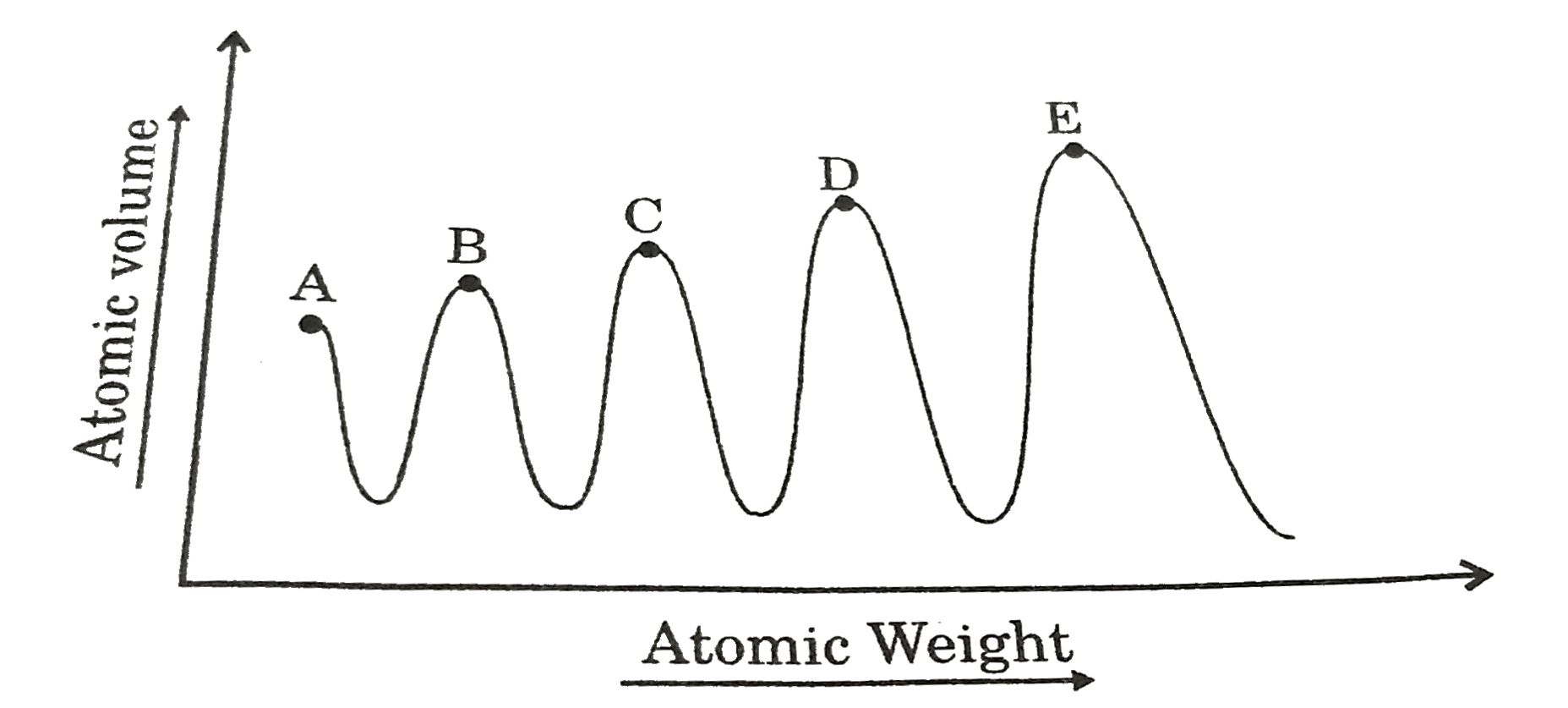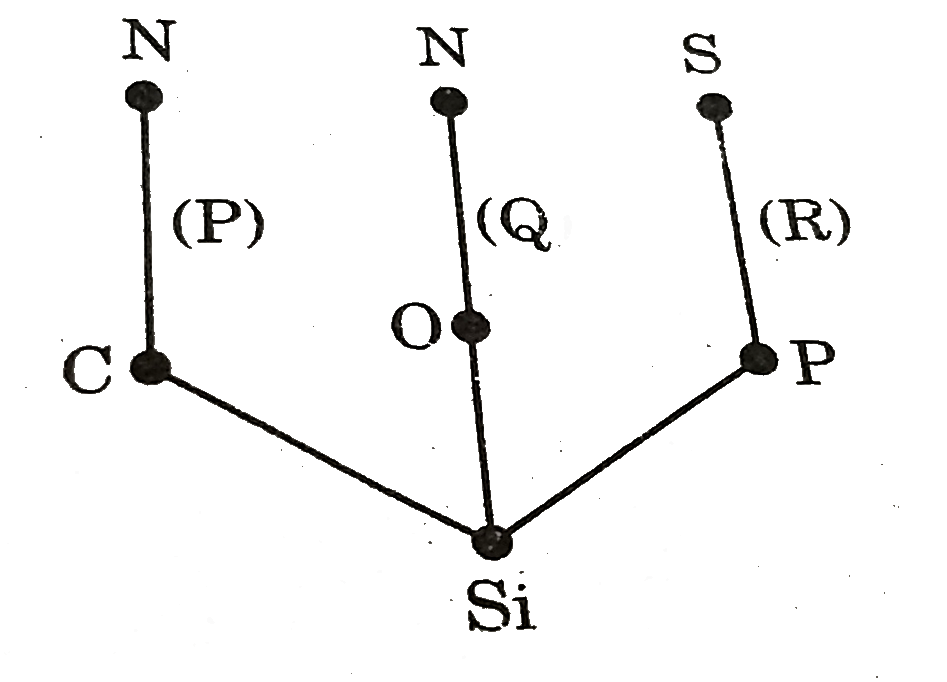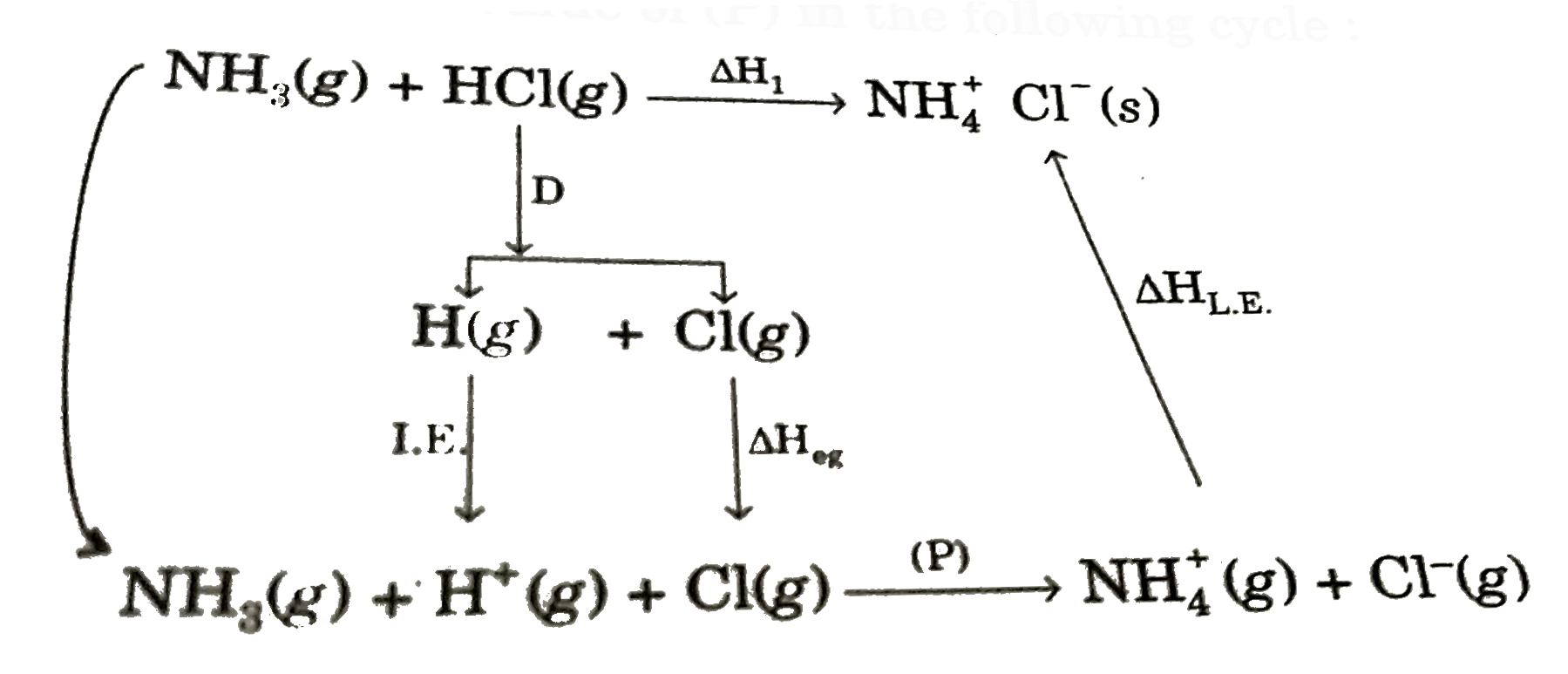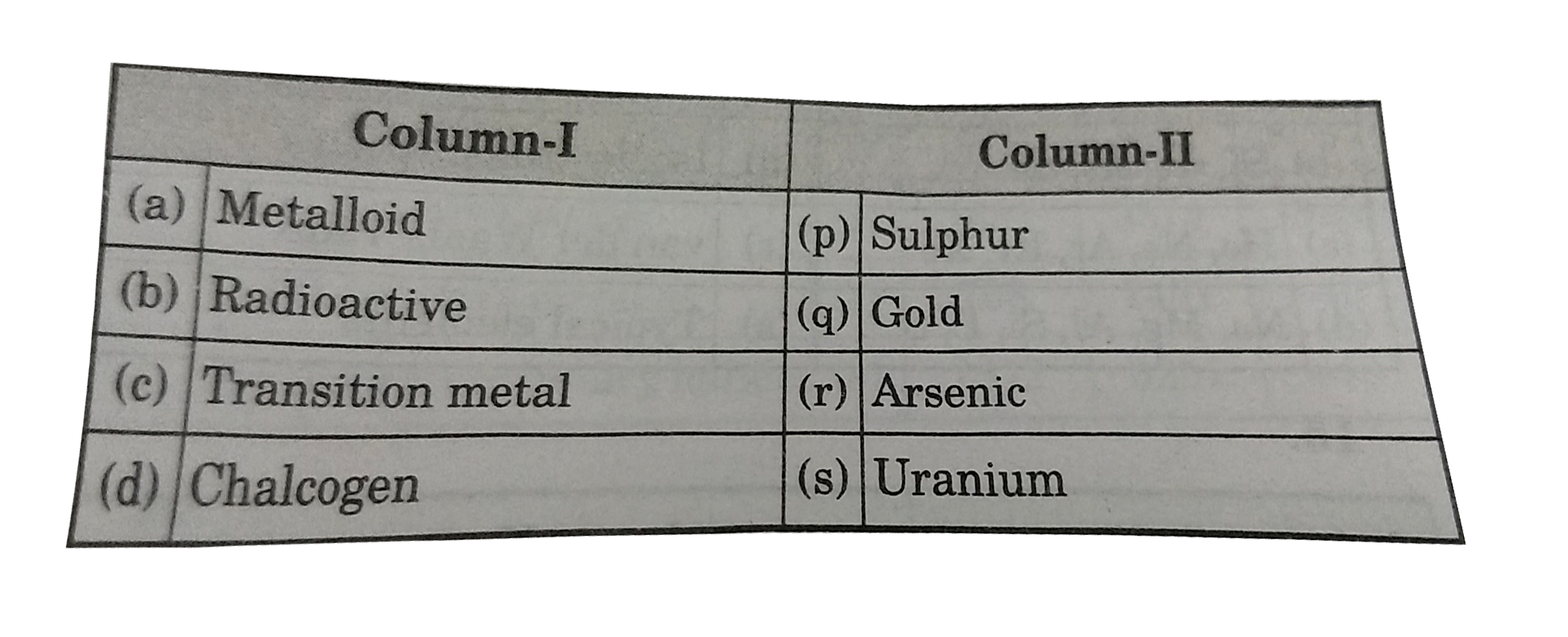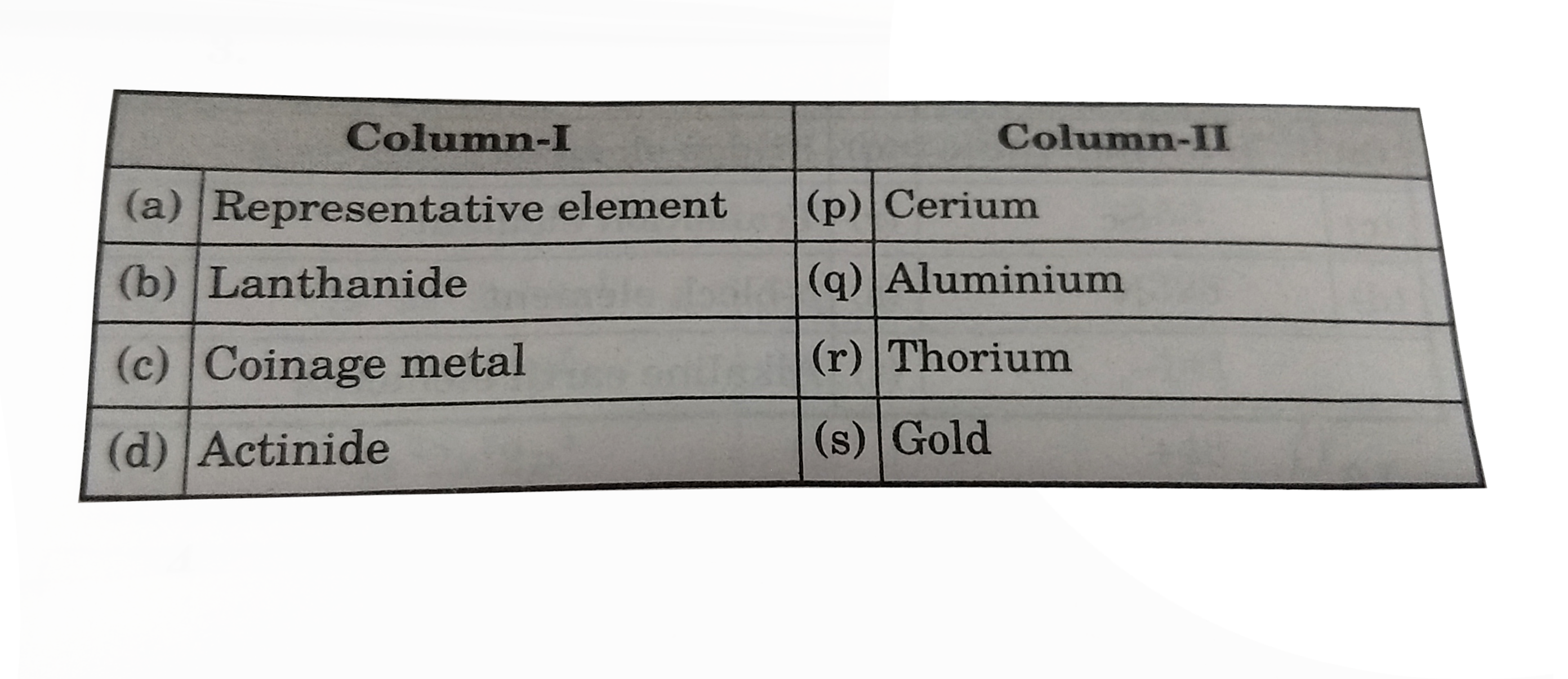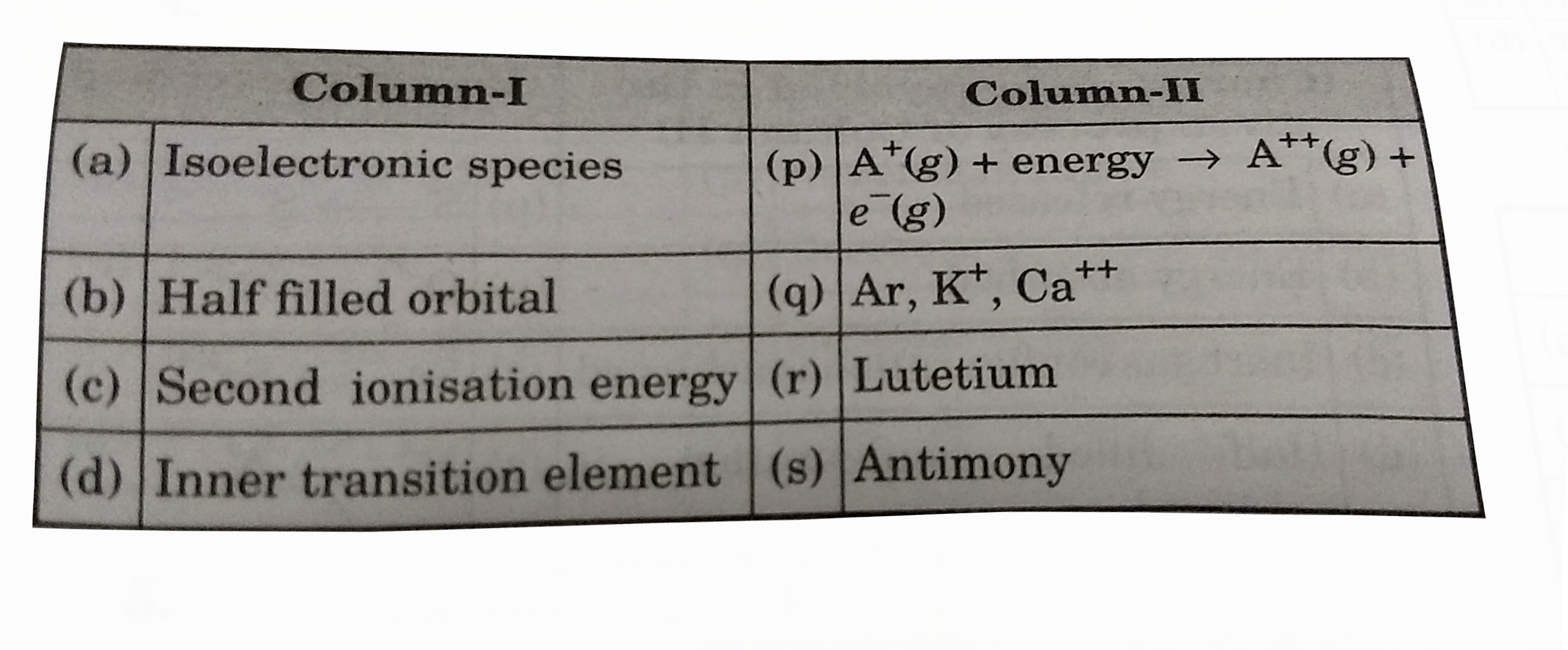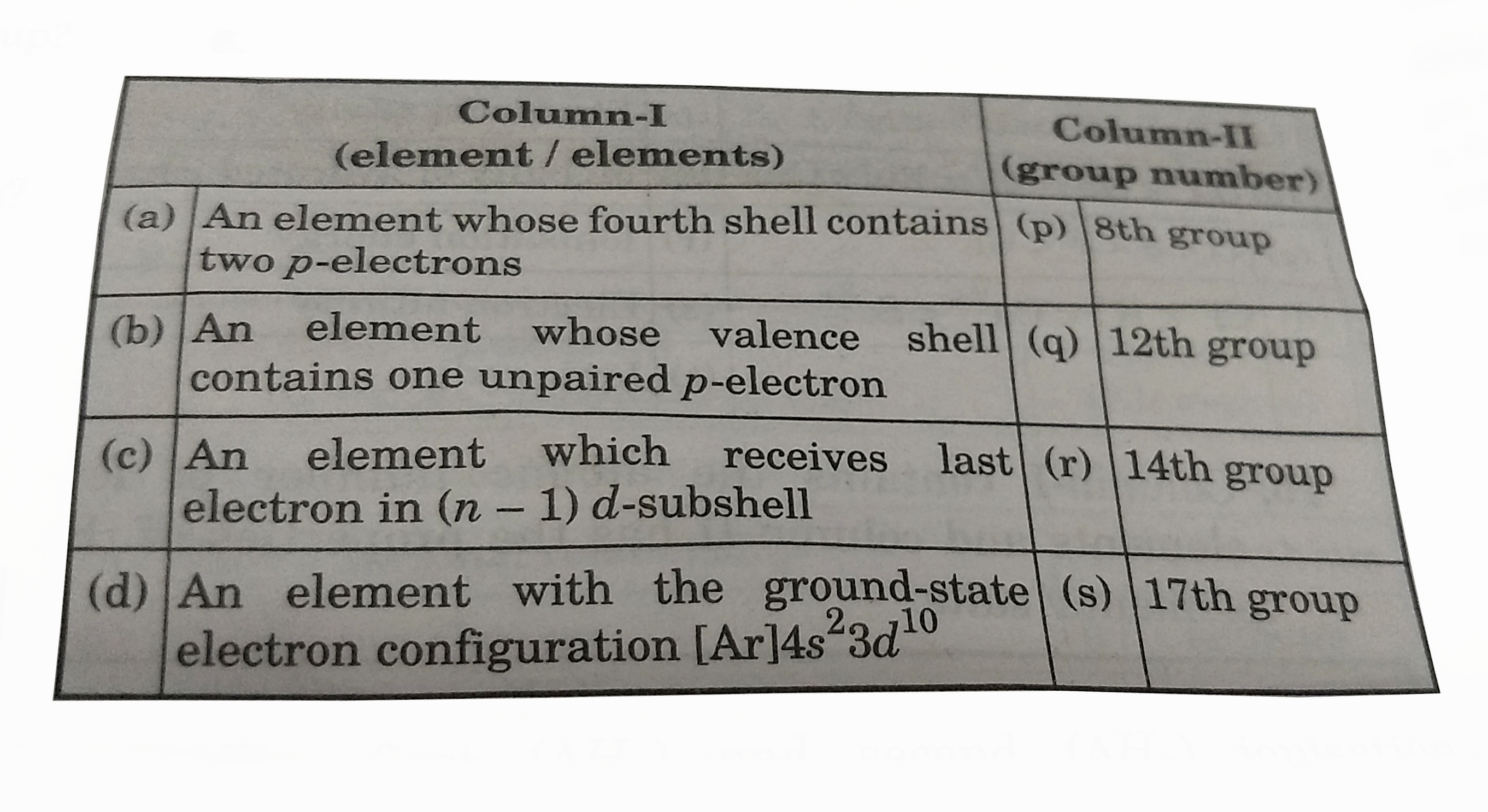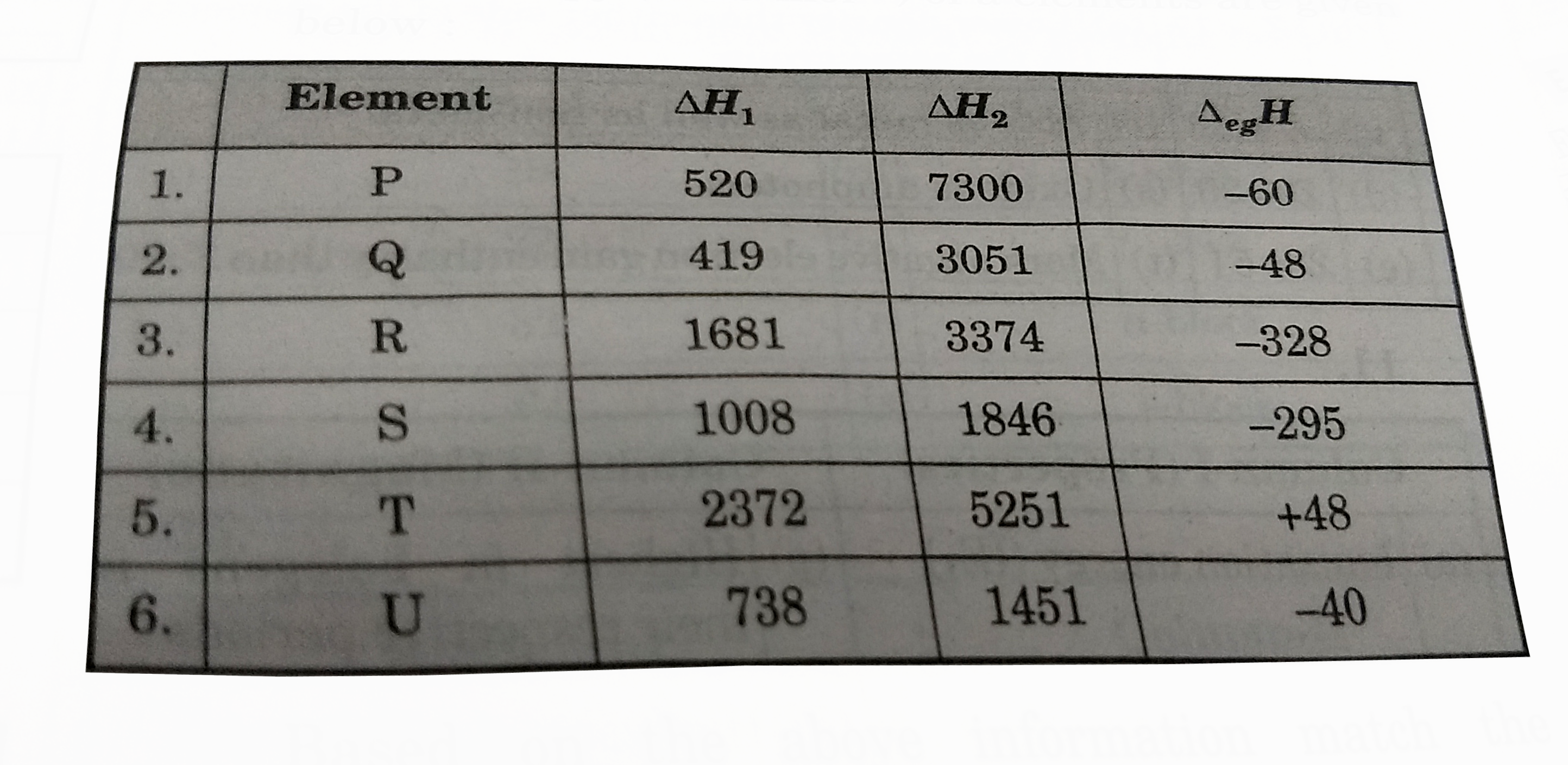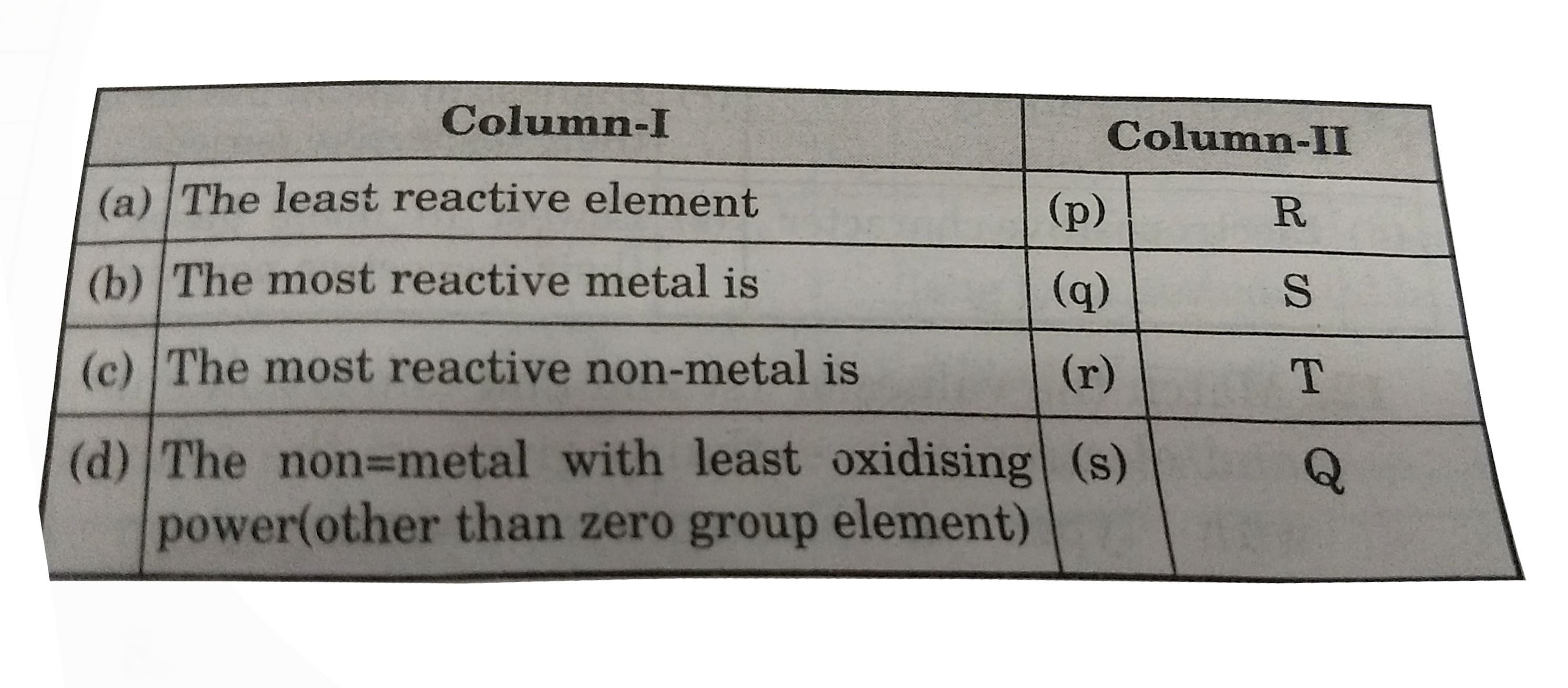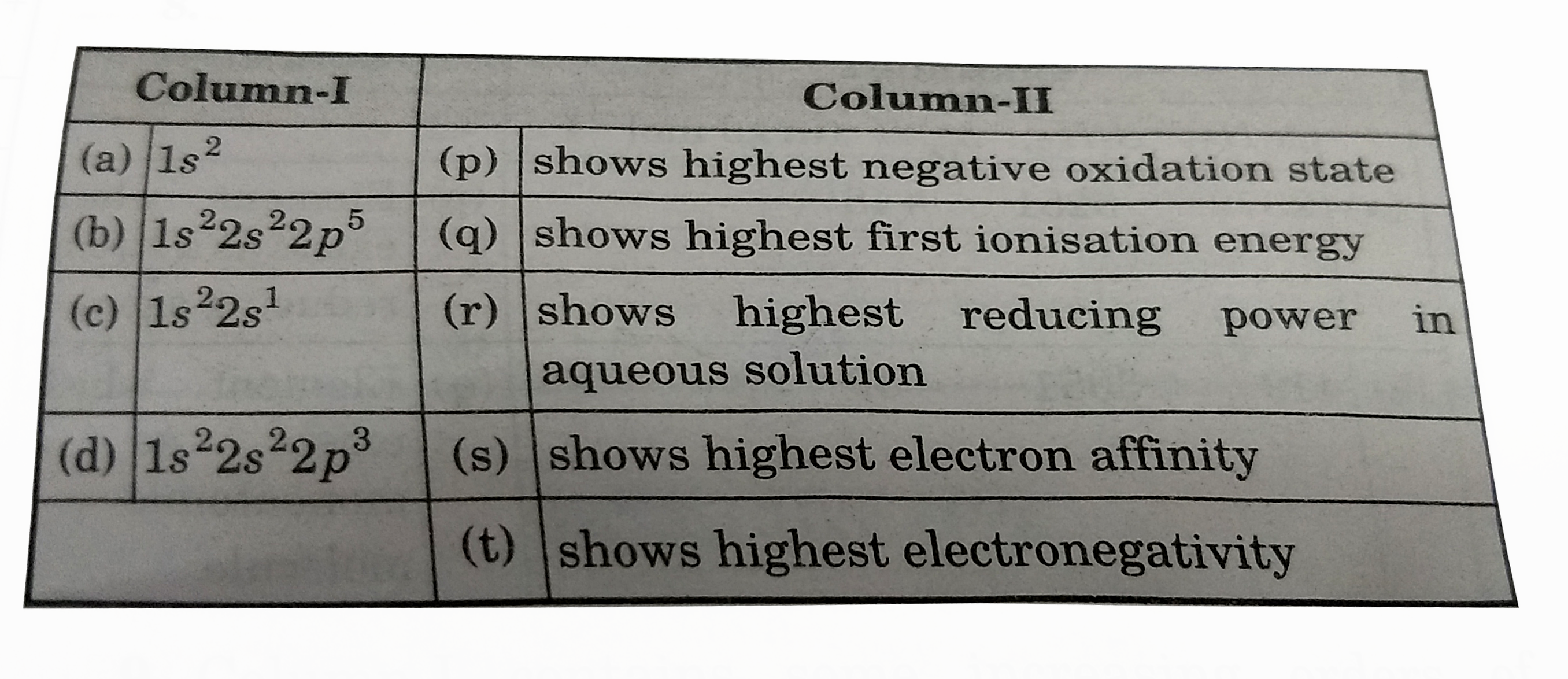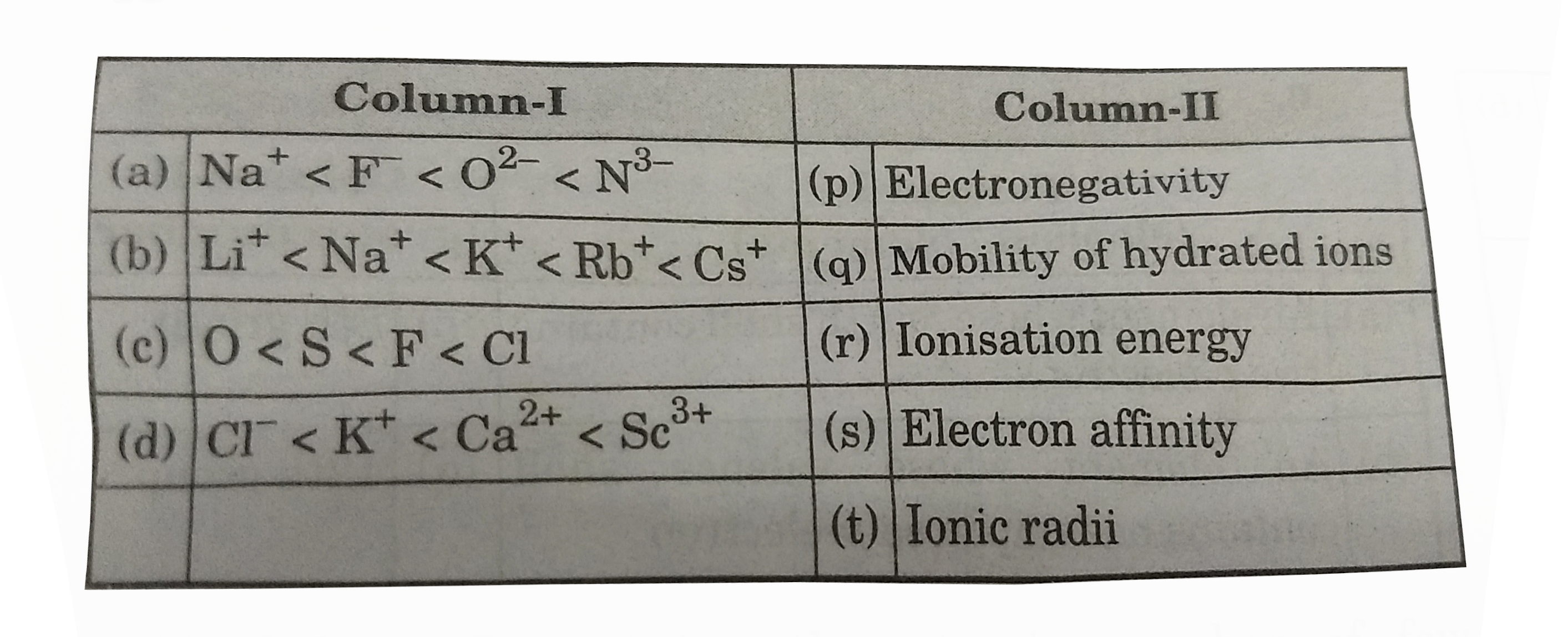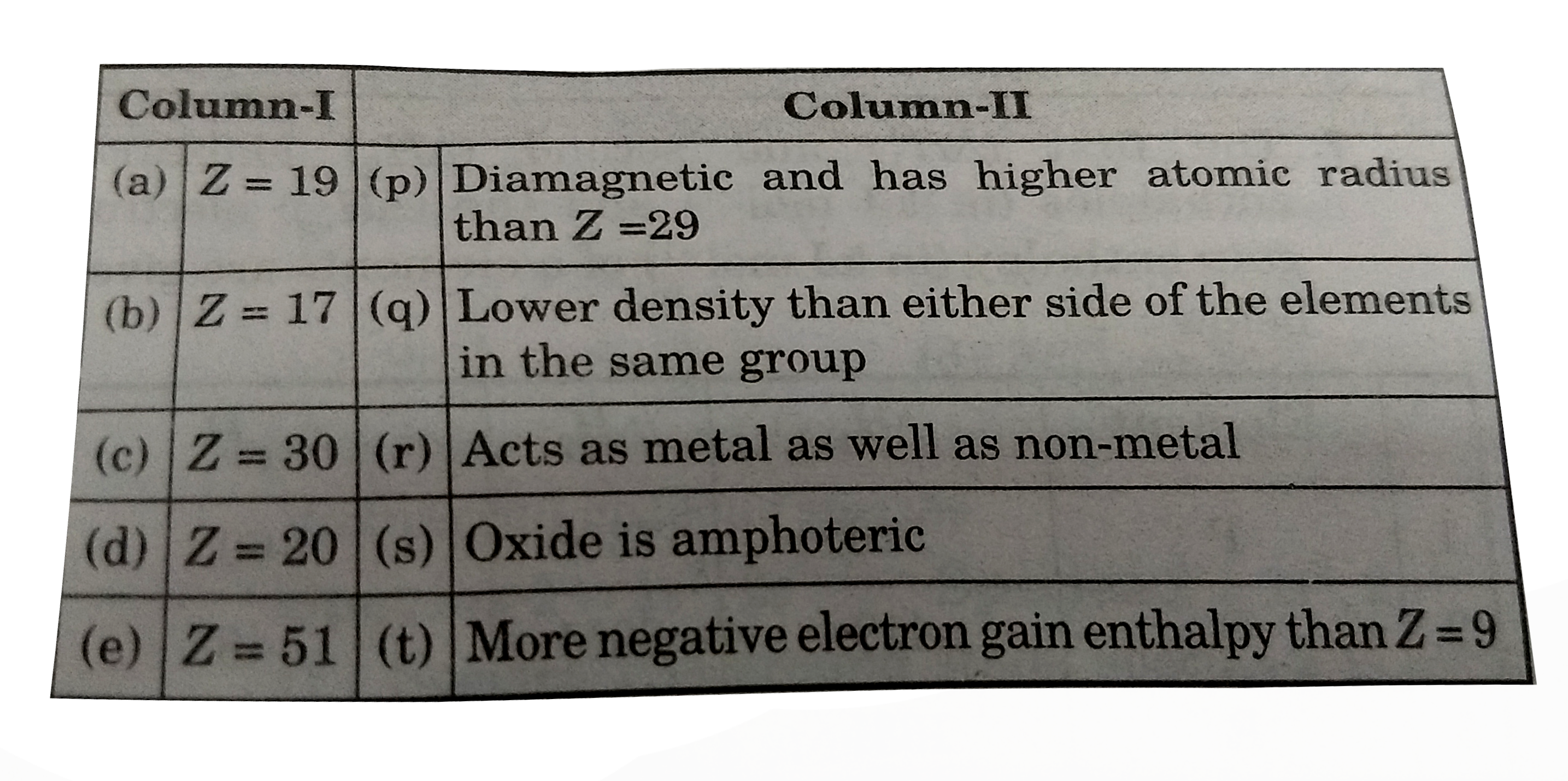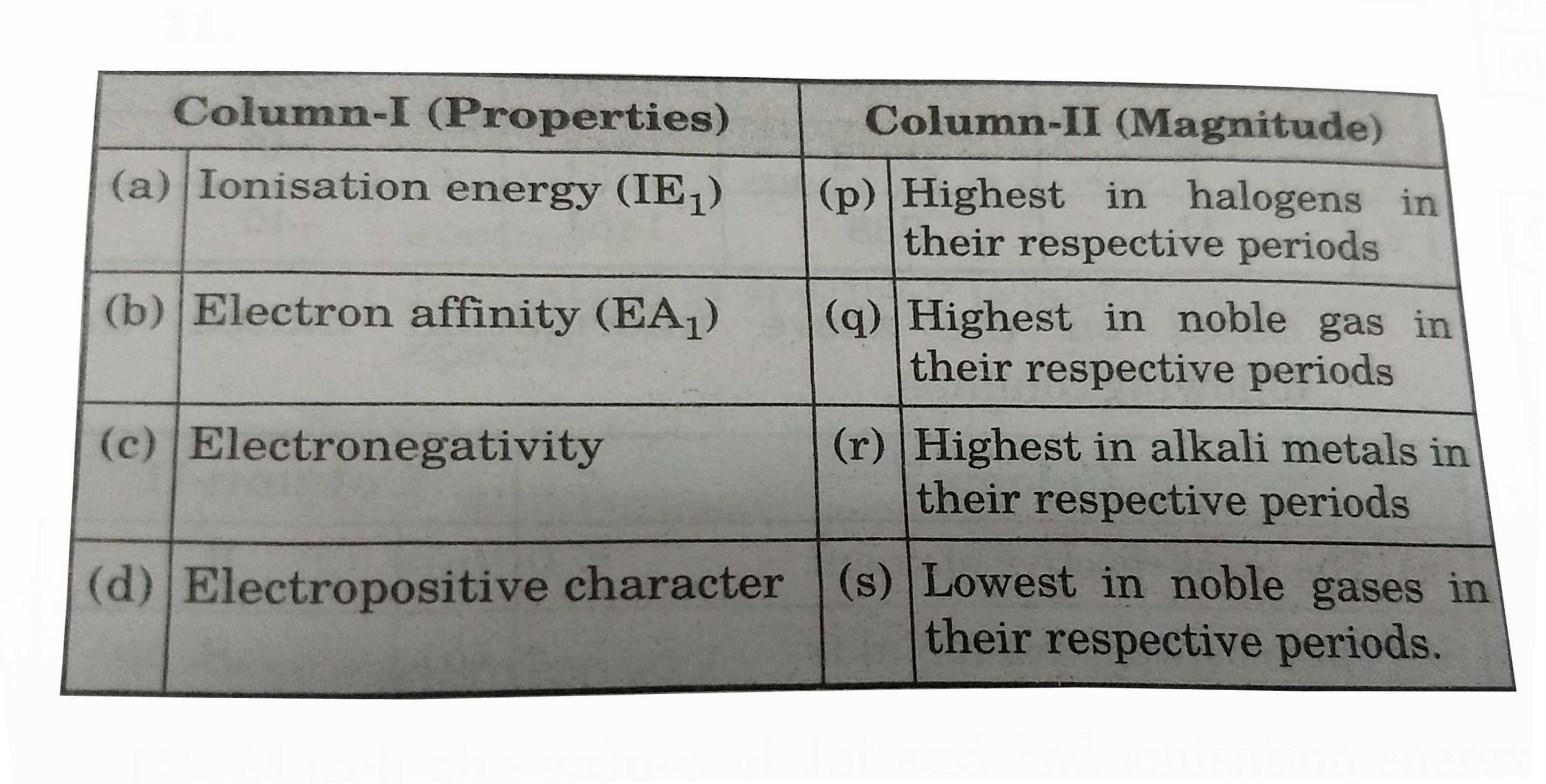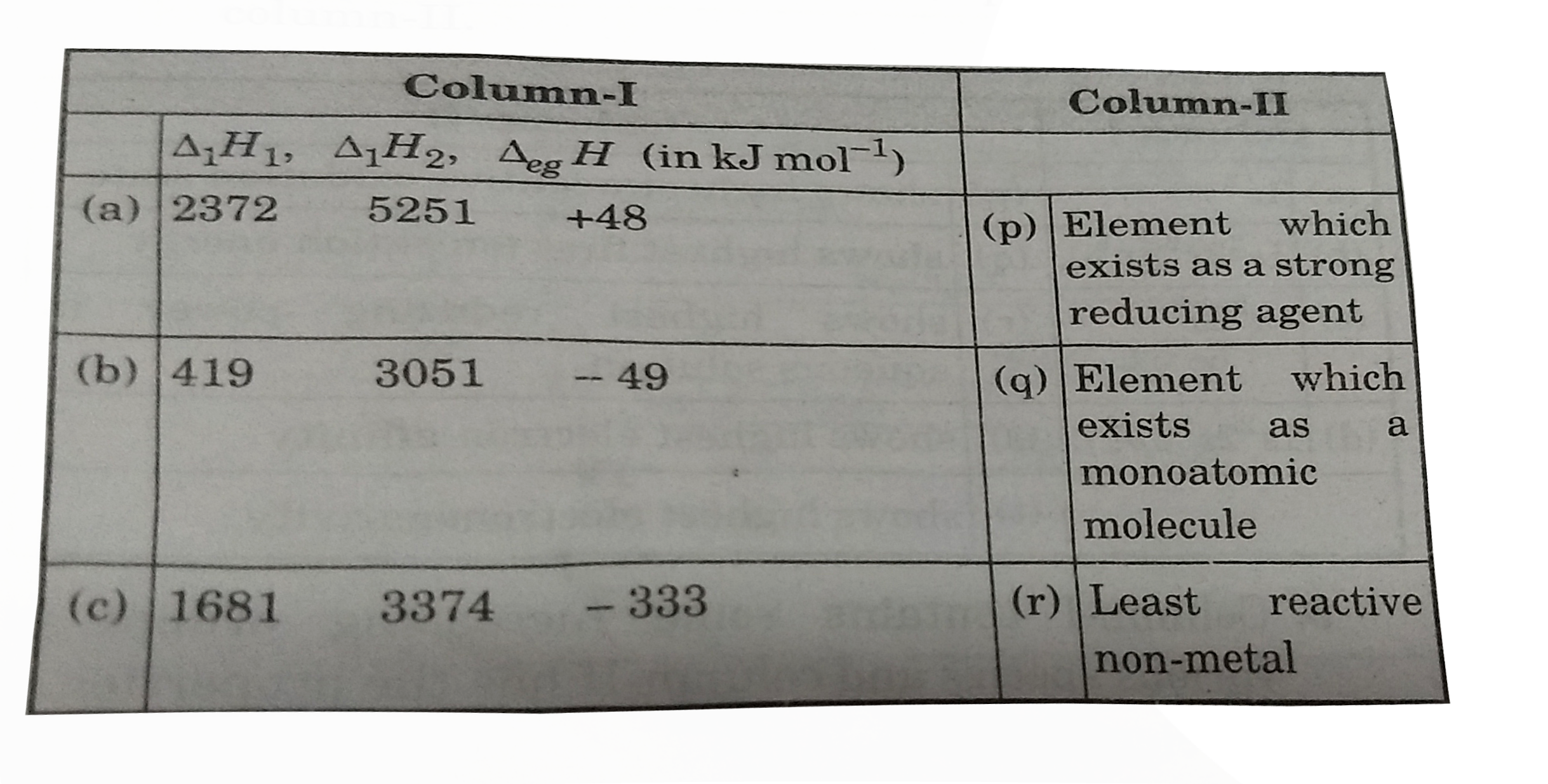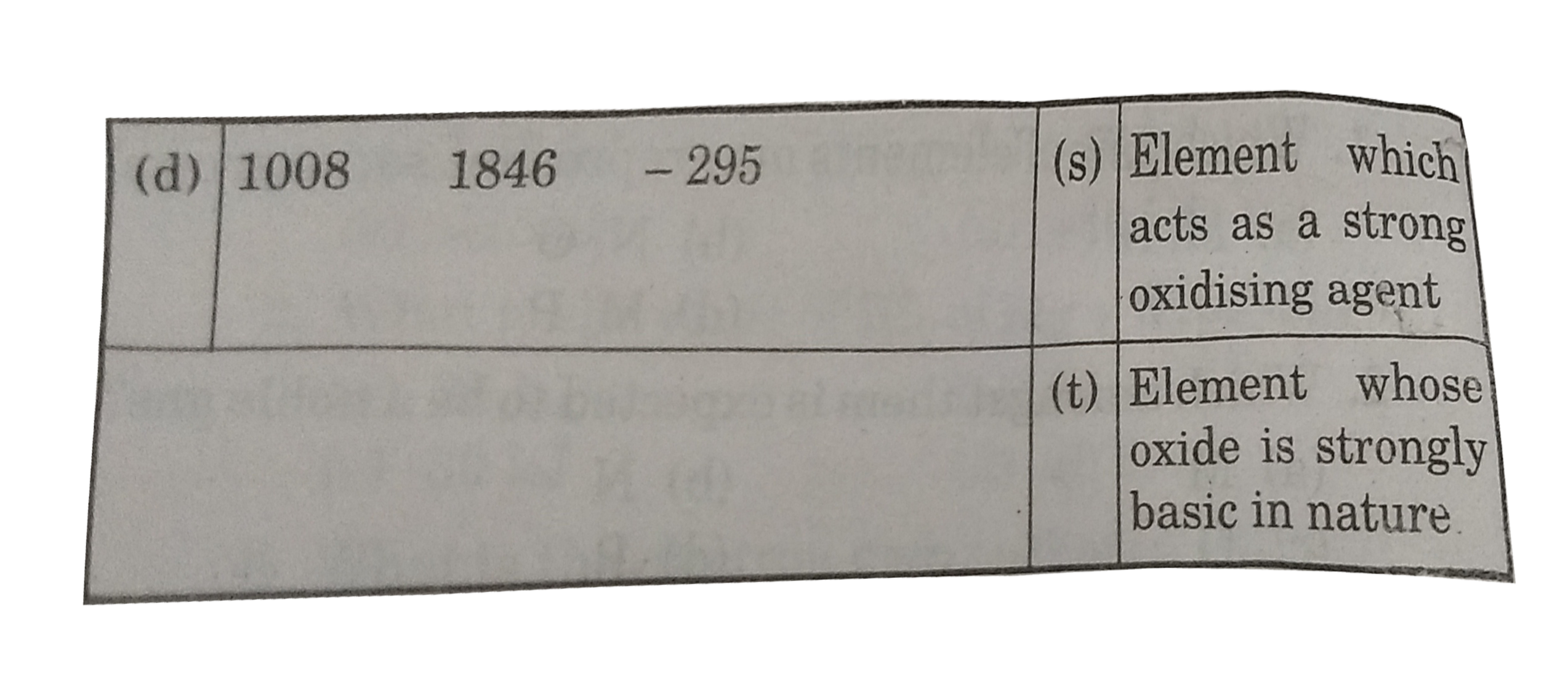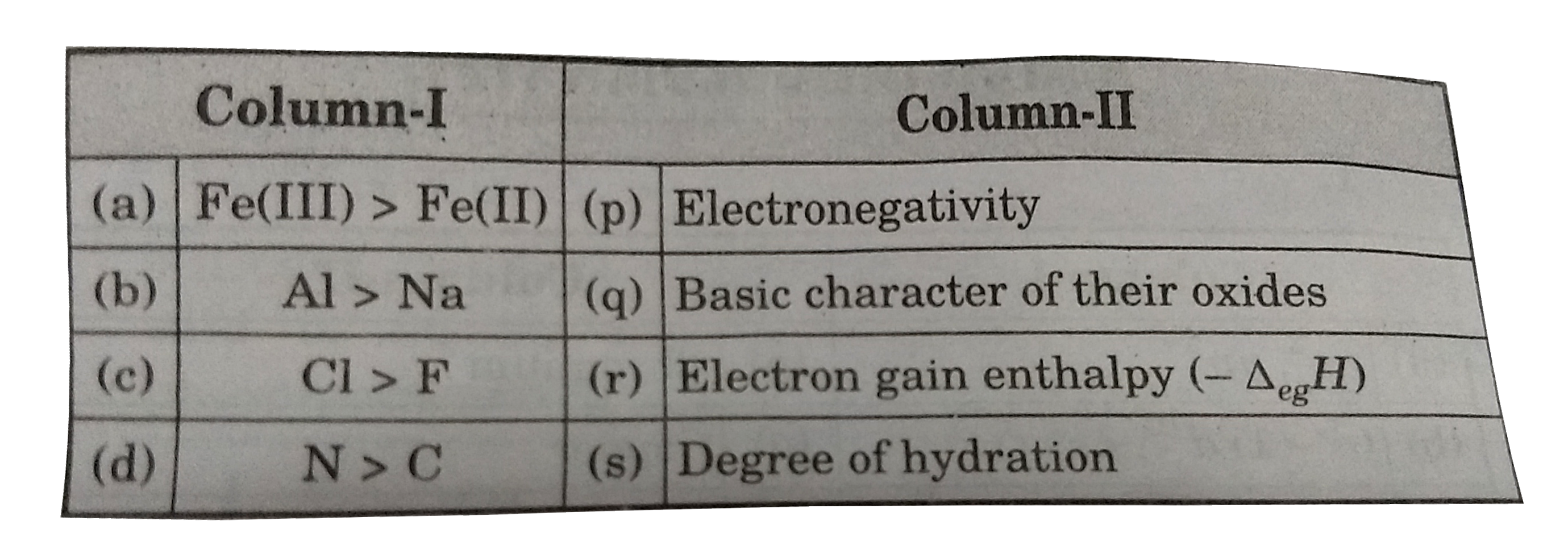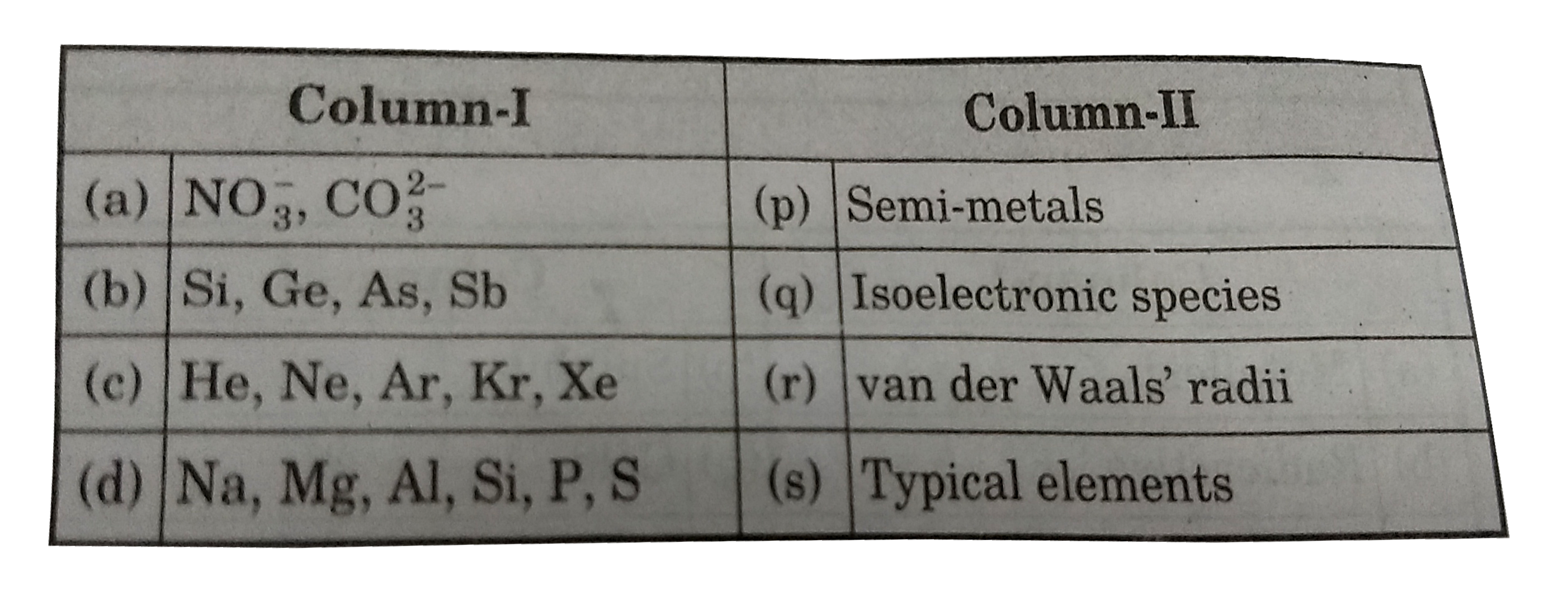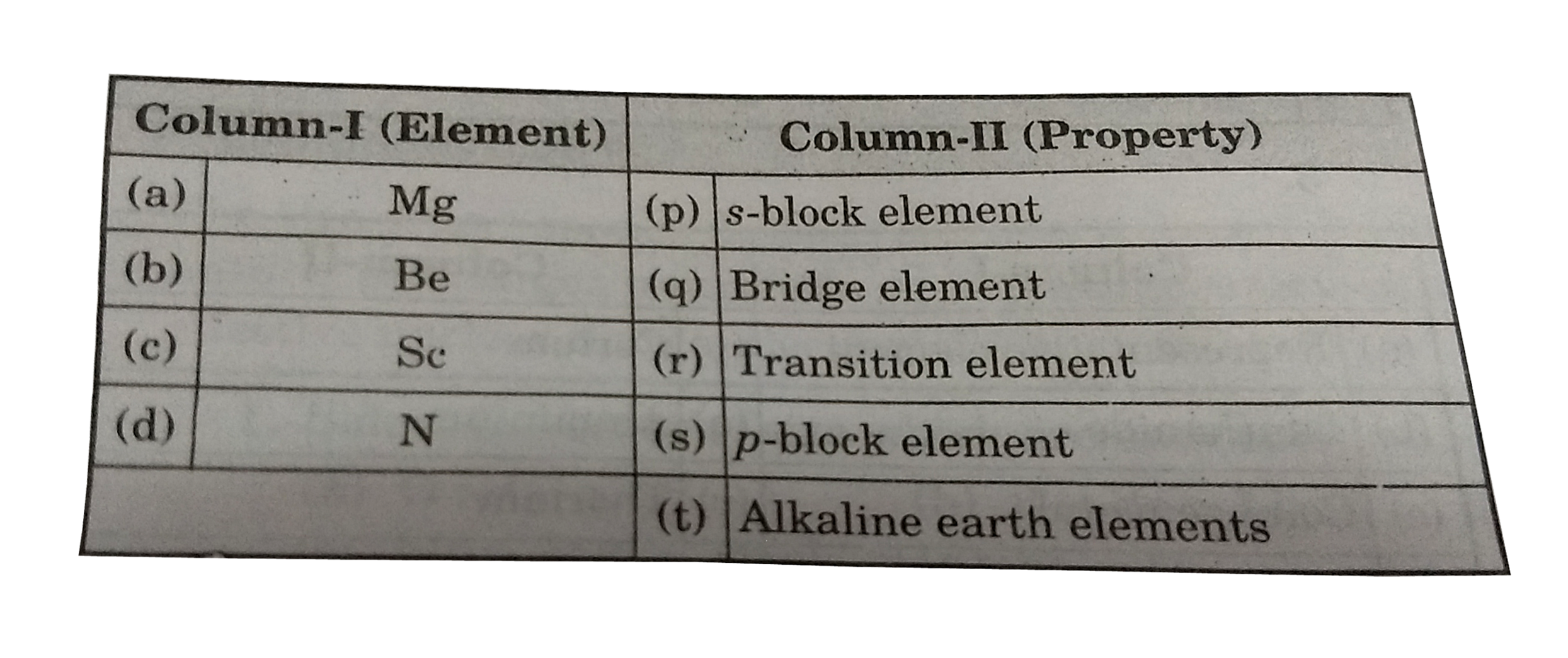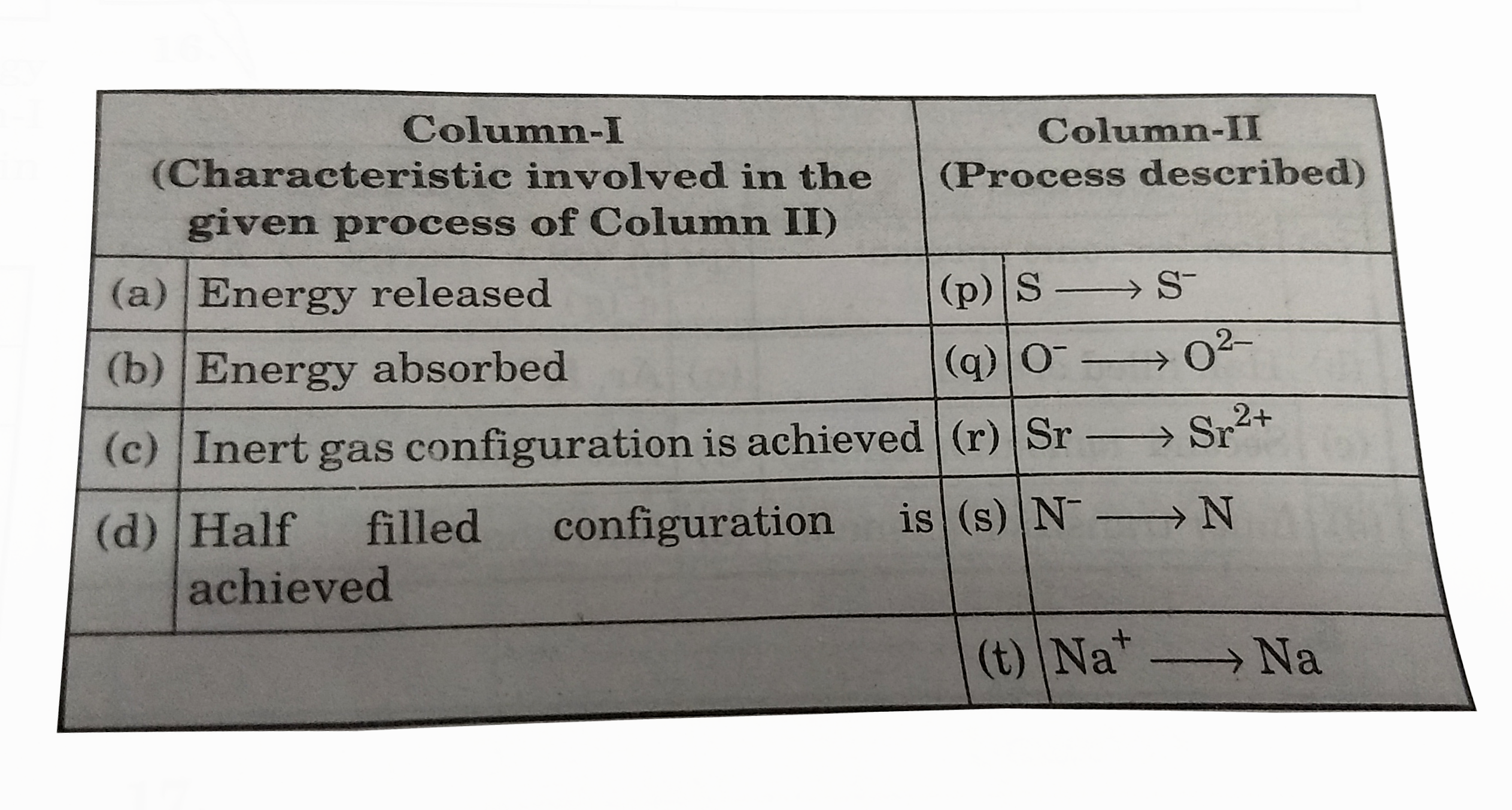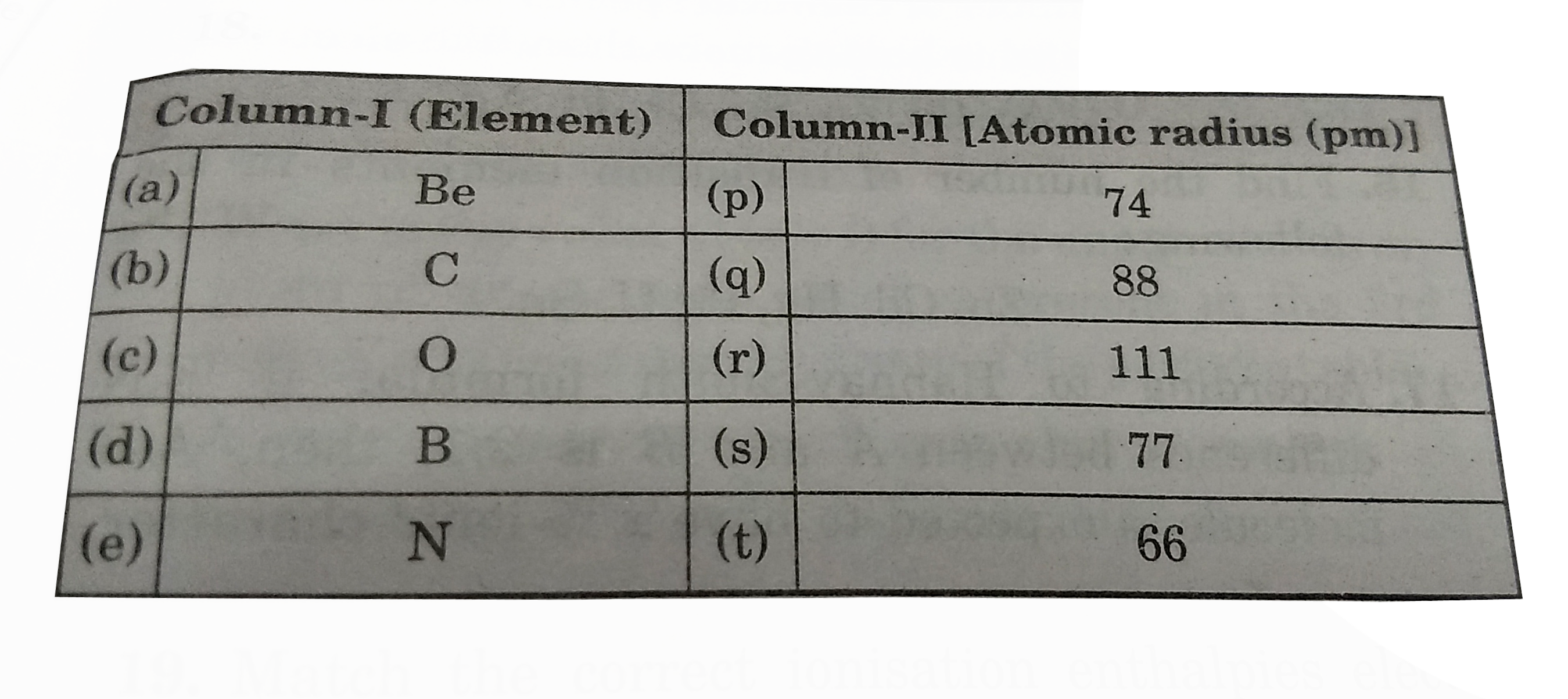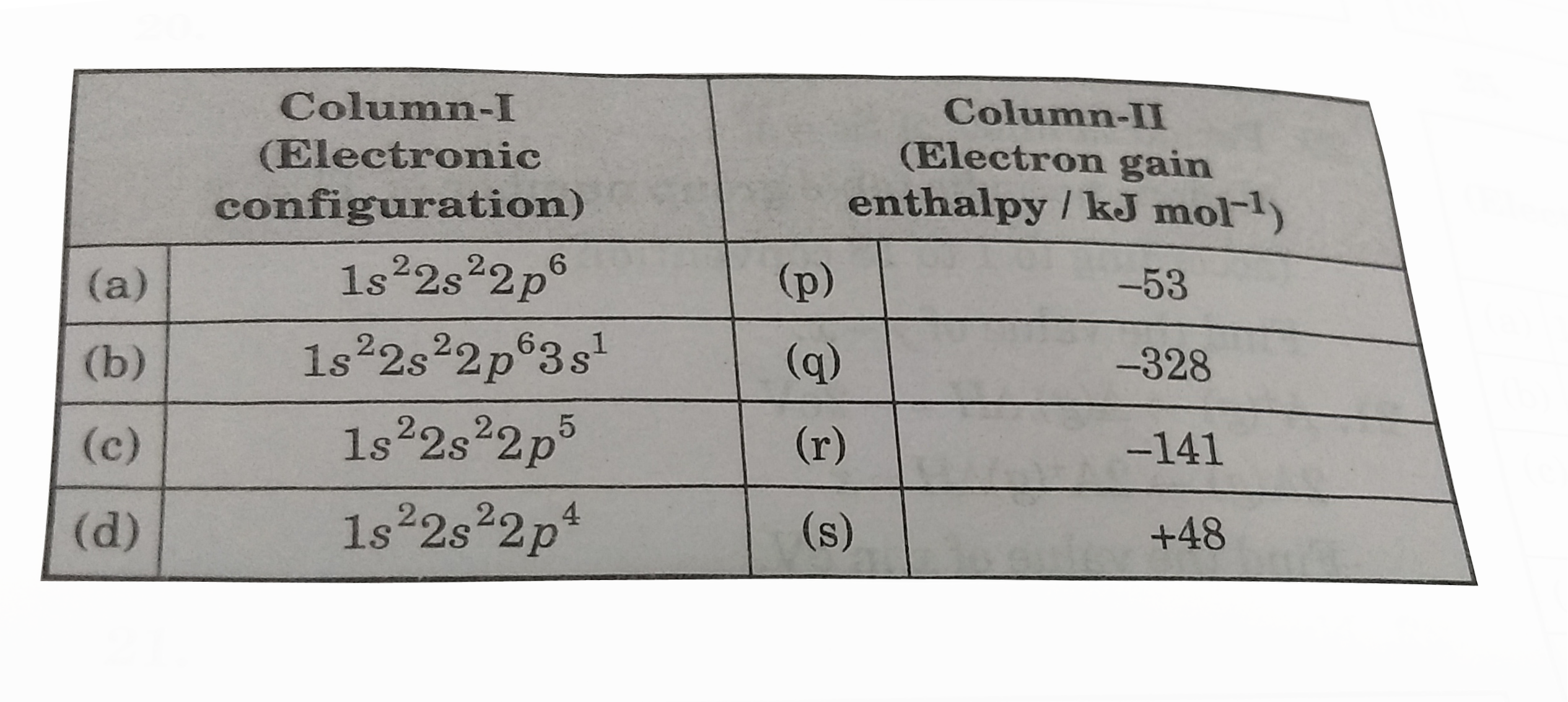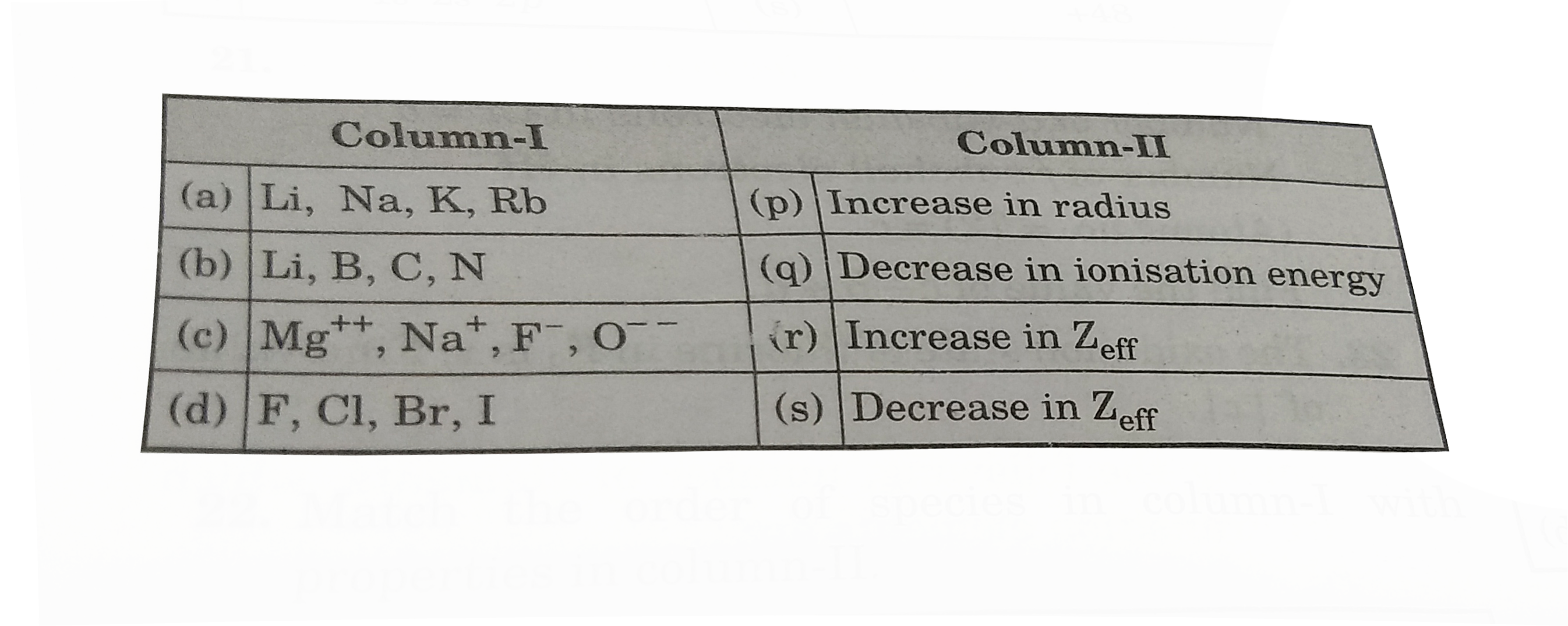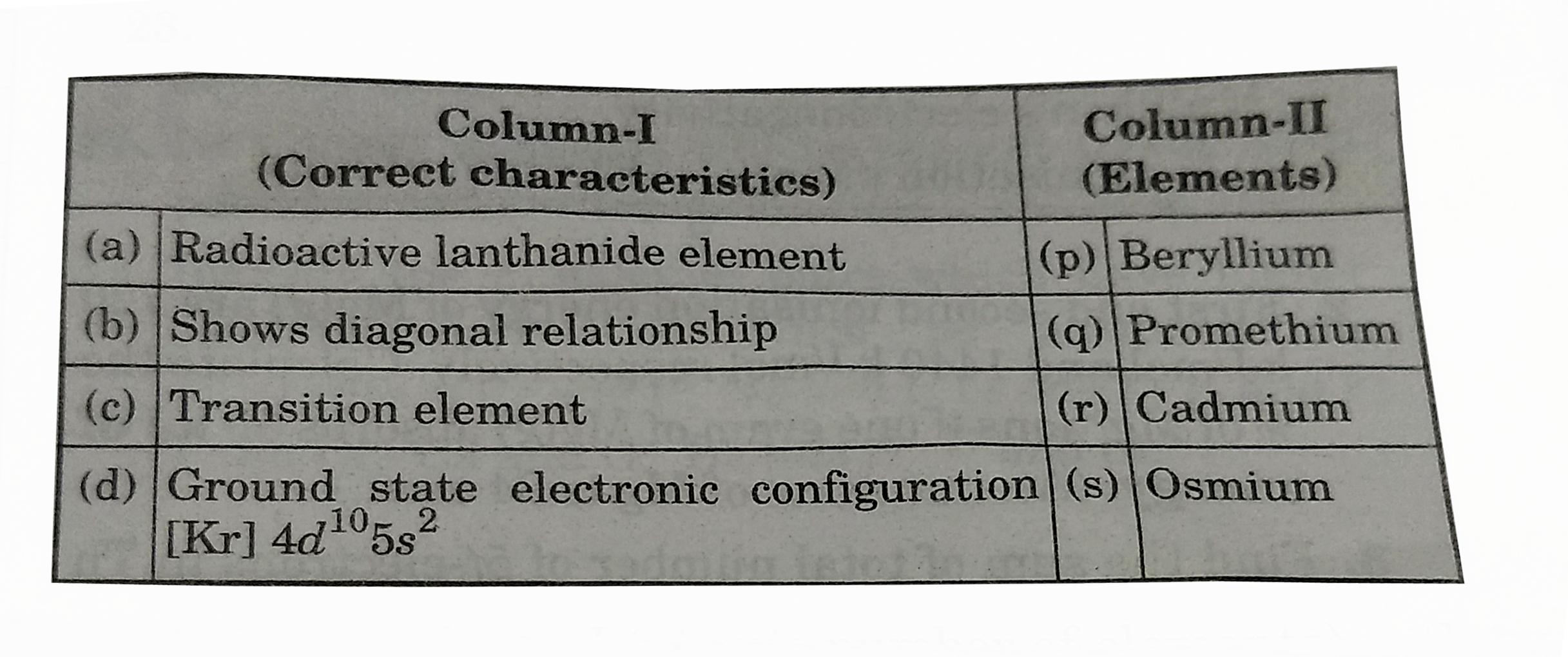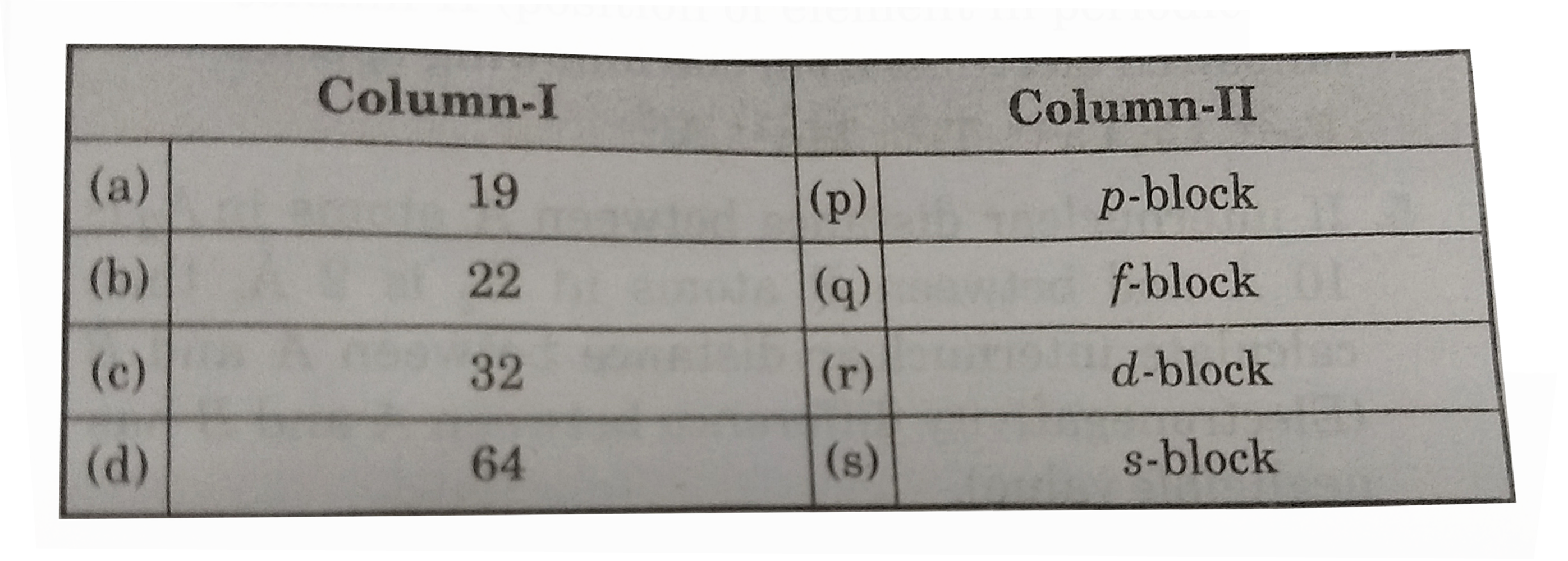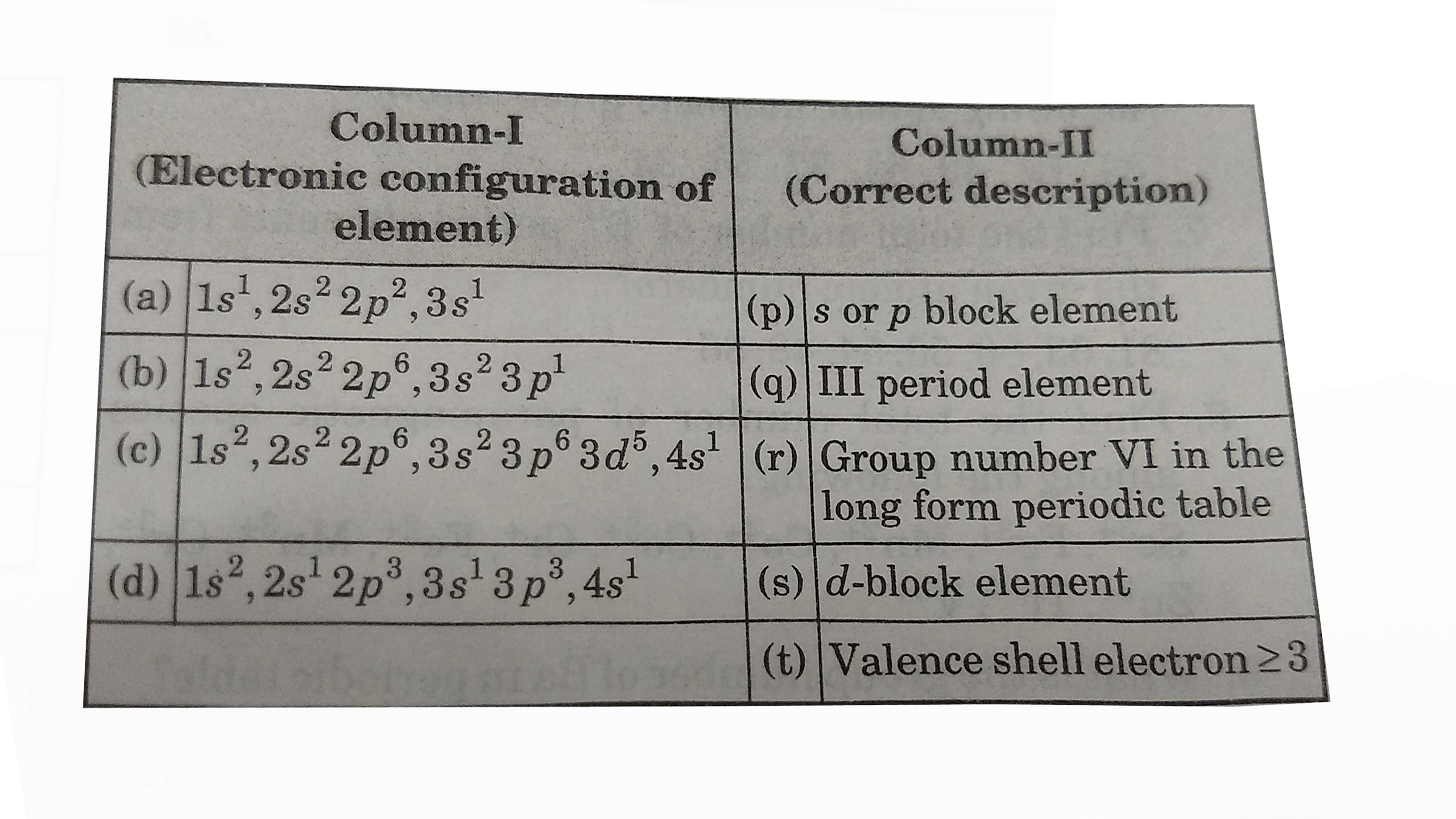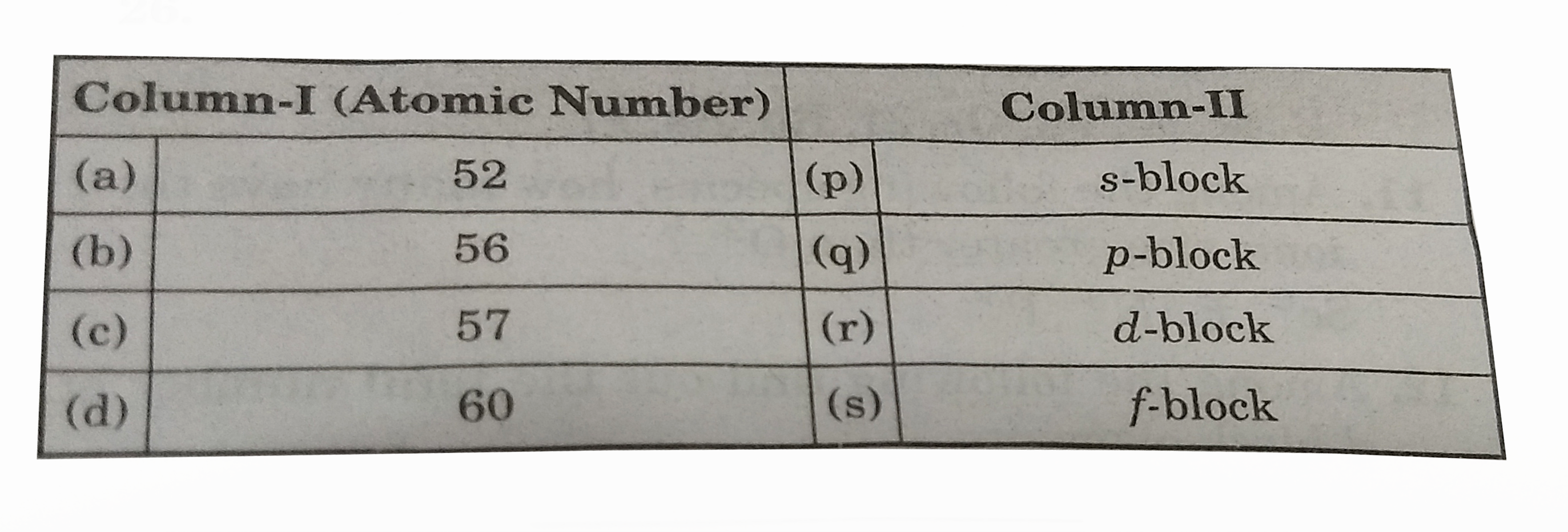Comprehension 20 from GRB CHEMISTRY (HINGLISH) PERIODIC TABLE for Class 11
| Class 11 | CHEMISTRY |
| Chapter | PERIODIC TABLE |
| GRB CHEMISTRY (HINGLISH) | Comprehension 20 |
| Medium | English |
| Academic Year | 2023-2024 |
Question 9
The statement that is not correct for the periodic classification of elements is : a)The properties of elements are the periodic functions of their atomic numbers. b)non-metallic elements are lesser in number than metallic elements. c)the first ionisation energies of elements along a period do not vary in a regular manner with increase in atomic number. d)for transition elements the d− subshells are filled with electrons monotonically with increase in atomic number.View SolutionQuestion 200
The incorrect statement Among the following is A)The first ionisation potential of Al is less than the first ionisation potential of Mg. B)The first ionisation potential of Na is less than the first ionisation potential of Mg. C)The second ionisation potential of Mg greater than the second ionisation potential of Na D)The third ionisation potential of Mg greater than the third ionisation potential of Al View SolutionQuestion 232
One method for calculating Zeff is to use the equation:
Zeff=√(E)(n2)1312kJ/mole
where E is the energy necessary to remove an electron from an atom and n is the principal quantum number of the electron. Use this equation to calculare Zeff value for the highest energetic electron in potassium. E=418.8kJ/moleView SolutionQuestion 251
Ionization energies vary from left to right across the periodic table. Factors that contribute to this variation include which of the following?
(P) Changes in the nuclear charge
(Q) Differences in shielding by valence electrons
(R) Differences in shielding by core electronsView SolutionQuestion 262
Given the correct order of initials T (true) of F (false) for following statement.
(I) Top positions of Lother-Mayer's atomic volume curve are occupied by Alkali metals
(II) Number of elements presents in the fifth period of the periodic table are 32.
(III) 2ndI.P. of Mg is less than the 2nd I.P. of Na.
(IV) A p-orbital can take maximum of six electrons. View SolutionQuestion 298
Consider the following statements.
Statement-1: Fluorine does not form any polyhalide as it has low F-F bond energy.
Statement-2: The chlorine has the most negative electron gain enthalpy.
Statement-3: The first ionization potentials of N and O atoms are 14.6 and 13.6eV respectively.
Which of the above statements are correct? View SolutionQuestion 336
Consider the following statements.
(P) IE(I) of nitrogen atom is ore than IE(I) of oxygen atom.
(Q) Electron affinity of oxygen is less than sulphur atom.
(R) Electronegativity of an atom has no relation with its ionization enthalpy and electron gain enthalpy.
Which of the above statements are correct? View SolutionQuestion 340
The group state electronic configuration of some elements, P,Q,R,S and T (these symbols represent the some of the known elements given in the periodic table) are as follows. ltbr> (P) :1s22s22p63s23p2
(Q) :1s22s22p63s23p64s1
(R) :1s22s22p63s23p1
(S) :1s22s22p63s23p63d54s1
(T) :1s22s22p^3s23p63s104s24p6
Match the electronic configurations of the elements with the properties given below and select the correct sequence by choosing the correct codes given.
(i) Element forms a cation which is isoelectronic with P3−.
(ii) Element which in its compounds can show a maximum oxidation state of +6 and that is coloured too.
(iii) Element has largest atomic radius and highest first ionisation energy in the respective period.
(iv) Element which has intermediate value of electronegativity and its oxide forms salts with strong acids and bases. View SolutionQuestion 344
A student went to meet his friend, where he saw that his friend was doing the study of a particular chemistry book. But he could not find the theoretical value of bond length in H-F but the found that rH and rF are 0.37Å and 0.72Å respectively and electronegativity of F and H are 4.0 and 2.1 respectively. what is bond length of H-F bond? View SolutionQuestion 411
The following order are given along with their metioned properties:
(P) Mg<Na<Sr<Ba [order of atomic size]
(Q) M+>M+2>M+3[M= hypothetical element, order of IP1 of respective ion]
(R) F>CI>Br>I [order of electronegativity]
(S) AI2O3<P2O5<So3<CI2O7 [order of basic nature]
(T) F−>CI−>Br>I− [order of ionic mobility in aqueous solution]
Which option represents group incorrect order? View SolutionQuestion 421
A,B and C are oxides of elements X,Y and Z respectively. X,Y and Z are in the same period of the periodic table. A gives an aqueous solution which turns blue litmus red. B reacts with both strong acids and strong alkalies. C gives an aqueous solution which is strongly alkaline. Which of the following statement is/are true ?
(P) All the three elements are metals.
(Q) The electronegativites decreases from X to Y to Z.
(R) The atomic radius increases in the order X<Y<Z.
(S) X,Y and Z could be phosphorus, aluminium and sodium respectively.View SolutionQuestion 422
Assertion: Electron gain enthalpy value of the 3rd peirod p-block elements of the mordern periodic table are generally more negative than the 2nd period element of the same group.
Reason: Due to smaller atomic size of the 2nd peirod element, its electron density is high which eases the addition of electron. View SolutionQuestion 425
Statement-1: The 5th period of periodic table contains 18 elements are 32.
Statement-1: n=5,l=0,1,2,3. The order in which the energy of available orbitals 4d,5s and 5p increases is 5s<4d<5p and the total number of orbitals avaiable are 9 and thus 18 electrons can be accommodated. View SolutionQuestion 426
Assertion: the 4f− and 5f− inner transition series of elements are placed separately at the bottom of the modern periodic table.
Reason : (i) Position of f-block elements prevents the undue expansion of the mordern periodic table, ie, maintains its structure.
(ii) Position of f-block elements preserves the principle of classification by keeping elements with similar properties in a single column. View SolutionQuestion 430
Statement-1: Third ionisation energy of phosphorous is larger than sulphur.
Statement-2: There is a larger amount of stability associated with filled s-and p-sub-shells (a noble gas electron configuration) which corresponds to having eight electrons in the valence shell of an atom or ion. View SolutionQuestion 435
Statement-1: The atomic radii of the elements of the oxygen family are smaller than the atomic radii of the corresponding elements of the nitrogen family.
Statement-2: The members of the oxygen family are more electronegative and thus have lower values of nuclear charge than those of the nitrogen family. View SolutionQuestion 442
Statement-1: Generally, ionisation enthalpy increases from left to right in a period.
Statement-2: When successive electrons are added to the orbitals in the same principal quantum level, the shielding effect of inner core of electrons does not increase very much to compensate for the increased attraction of the electron to the nucleus. View SolutionQuestion 515
The periodicity is related to the electronic configuration. That is, all chemical and physical properties are a manifestation of the electronic configuratio of the elements. The atomic and ionic radii generally decrease in a period from left to right. As a consequence, the ionization enthalpes generally increase and electron gain enthalpies become more negative across a period. In order words, the ionization enthalpy of the extreme left element in a period is the least and the electron gain enthalpy of the element on the extreme right is the highest negative. This results into high chemical reactivity at the two extremes and the lowest in the centre. Similary, down the group, the increase in ionization enthalpies and a regular decrease (with exception in some third period elements) in electron gain enthalpies in the case of main group elements. The loss and gain of electrons can be co-related with the reducing and oxidising behaviour, and also with metallic and non-metallic character respectively of the elements.
The correct order of the metallic character is:View SolutionQuestion 516
The periodicity is related to the electronic configuration. That is, all chemical and physical properties are a manifestation of the electronic configuratio of the elements. The atomic and ionic radii generally decrease in a period from left to right. As a consequence, the ionization enthalpes generally increase and electron gain enthalpies become more negative across a period. In order words, the ionization enthalpy of the extreme left element in a period is the least and the electron gain enthalpy of the element on the extreme right is the highest negative. This results into high chemical reactivity at the two extremes and the lowest in the centre. Similary, down the group, the increase in ionization enthalpies and a regular decrease (with exception in some third period elements) in electron gain enthalpies in the case of main group elements. The loss and gain of electrons can be co-related with the reducing and oxidising behaviour, and also with metallic and non-metallic character respectively of the elements.
The correct order of the non-metallic character is:View SolutionQuestion 517
The periodicity is related to the electronic configuration. That is, all chemical and physical properties are a manifestation of the electronic configuratio of the elements. The atomic and ionic radii generally decrease in a period from left to right. As a consequence, the ionization enthalpes generally increase and electron gain enthalpies become more negative across a period. In order words, the ionization enthalpy of the extreme left element in a period is the least and the electron gain enthalpy of the element on the extreme right is the highest negative. This results into high chemical reactivity at the two extremes and the lowest in the centre. Similary, down the group, the increase in ionization enthalpies and a regular decrease (with exception in some third period elements) in electron gain enthalpies in the case of main group elements. The loss and gain of electrons can be co-related with the reducing and oxidising behaviour, and also with metallic and non-metallic character respectively of the elements.
Which of the following statements is incorrect? View SolutionQuestion 518
The amount of energy required to remove, an electron from the last orbit of an isolated (free) atom in gaseous state is known as ionisation energy or first ionisation of the element. Similarly the energy required for the removal of the electron from the unipositive ion (M+ produced above) is referred to as second ionization energy and thus the third, fourth etc. The ionisation energy depends on various factors like nuclear charge, size of atom, type configurations, screening effect and penetration power of the electrons.
Which of the following statements is correct? View SolutionQuestion 519
The amount of energy required to remove, an electron from the last orbit of an isolated (free) atom in gaseous state is known as ionisation energy or first ionisation of the element. Similarly the energy required for the removal of the electron from the unipositive ion (M+ produced above) is referred to as second ionization energy and thus the third, fourth etc. The ionisation energy depends on various factors like nuclear charge, size of atom, type configurations, screening effect and penetration power of the electrons.
The domination factor responsible for the decreasing ionisation energies of the elements of moving down the group is:View SolutionQuestion 520
The amount of energy required to remove, an electron from the last orbit of an isolated (free) atom in gaseous state is known as ionisation energy or first ionisation of the element. Similarly the energy required for the removal of the electron from the unipositive ion (M+ produced above) is referred to as second ionization energy and thus the third, fourth etc. The ionisation energy depends on various factors like nuclear charge, size of atom, type configurations, screening effect and penetration power of the electrons.
Which of the following order is not correct?View SolutionQuestion 521
Numerous forms of the periodic table have been revised from time to time. A modern verion, which is most convenient and widely used is the long or extended from the periodic table. The aufbau principle (electrons are filled in the progressive order of their increasing energy i.e., by n + l rule) and the electronic configuration of atom provides a theoretical foundation for the periodic classification. The horizontal rows are called periods. There are altogether seven periods. The first period consists of 2 elements. The subsequent periods consist of 8, 8, 18 and 32 elements respectively. The seventh maximum of 32 elements. Elements having similar outer electronic configurations in their atoms are grouped in vertical columns. These are referred to as groups or famillies. According to the recommendation of IUPAC, the groups are numbered 1 to 18 replacing the older notation of groups 0, IA, IIA ..... VIIA, VIII, IB, ...... VII B. Each successive period in the periodic table is associated with the filling up of next higher principal energy level following aufbua sequence. The number of elements in each period is twice the number of atomic orbitals avaliable in the energy level that is being filled. All the elements are classified into four blocks, i.e., s-block, p-block, d-block and f-block depending on the type of atomic orbitals that are being filled with the last electron of the element.
The element with atomic number 56 is likely to have the same outer shell configuration as the element with atomic number. View SolutionQuestion 522
Numerous forms of the periodic table have been revised from time to time. A modern verion, which is most convenient and widely used is the long or extended from the periodic table. The aufbau principle (electrons are filled in the progressive order of their increasing energy i.e., by n + l rule) and the electronic configuration of atom provides a theoretical foundation for the periodic classification. The horizontal rows are called periods. There are altogether seven periods. The first period consists of 2 elements. The subsequent periods consist of 8, 8, 18 and 32 elements respectively. The seventh maximum of 32 elements. Elements having similar outer electronic configurations in their atoms are grouped in vertical columns. These are referred to as groups or famillies. According to the recommendation of IUPAC, the groups are numbered 1 to 18 replacing the older notation of groups 0, IA, IIA ..... VIIA, VIII, IB, ...... VII B. Each successive period in the periodic table is associated with the filling up of next higher principal energy level following aufbua sequence. The number of elements in each period is twice the number of atomic orbitals avaliable in the energy level that is being filled. All the elements are classified into four blocks, i.e., s-block, p-block, d-block and f-block depending on the type of atomic orbitals that are being filled with the last electron of the element.
Elements a,b,c,d and e have the following electronic configurations.
(a) 1s2,2s22p1
(b) 1s2,2s22p)(6),3s23p1
(c) 1s2,2s22p6,3s23p1
(d) 1s2,2s22p6,3s23p5
(e) 1s2,2s22p6,3s23p5
Which among these will belong to the same group in periodic table? View SolutionQuestion 523
Numerous forms of the periodic table have been revised from time to time. A modern verion, which is most convenient and widely used is the long or extended from the periodic table. The aufbau principle (electrons are filled in the progressive order of their increasing energy i.e., by n + l rule) and the electronic configuration of atom provides a theoretical foundation for the periodic classification. The horizontal rows are called periods. There are altogether seven periods. The first period consists of 2 elements. The subsequent periods consist of 8, 8, 18 and 32 elements respectively. The seventh maximum of 32 elements. Elements having similar outer electronic configurations in their atoms are grouped in vertical columns. These are referred to as groups or famillies. According to the recommendation of IUPAC, the groups are numbered 1 to 18 replacing the older notation of groups 0, IA, IIA ..... VIIA, VIII, IB, ...... VII B. Each successive period in the periodic table is associated with the filling up of next higher principal energy level following aufbua sequence. The number of elements in each period is twice the number of atomic orbitals avaliable in the energy level that is being filled. All the elements are classified into four blocks, i.e., s-block, p-block, d-block and f-block depending on the type of atomic orbitals that are being filled with the last electron of the element.
If aufbau rule is not followed, Ca-20 will be placed in........block. View SolutionQuestion 524
Numerous forms of the periodic table have been revised from time to time. A modern verion, which is most convenient and widely used is the long or extended from the periodic table. The aufbau principle (electrons are filled in the progressive order of their increasing energy i.e., by n + l rule) and the electronic configuration of atom provides a theoretical foundation for the periodic classification. The horizontal rows are called periods. There are altogether seven periods. The first period consists of 2 elements. The subsequent periods consist of 8, 8, 18 and 32 elements respectively. The seventh maximum of 32 elements. Elements having similar outer electronic configurations in their atoms are grouped in vertical columns. These are referred to as groups or famillies. According to the recommendation of IUPAC, the groups are numbered 1 to 18 replacing the older notation of groups 0, IA, IIA ..... VIIA, VIII, IB, ...... VII B. Each successive period in the periodic table is associated with the filling up of next higher principal energy level following aufbua sequence. The number of elements in each period is twice the number of atomic orbitals avaliable in the energy level that is being filled. All the elements are classified into four blocks, i.e., s-block, p-block, d-block and f-block depending on the type of atomic orbitals that are being filled with the last electron of the element.
What is the position of the element in the periodic table satisfying the electronic configuration (n1)d1ns2 for n=4? View SolutionQuestion 525
Numerous forms of the periodic table have been revised from time to time. A modern verion, which is most convenient and widely used is the long or extended from the periodic table. The aufbau principle (electrons are filled in the progressive order of their increasing energy i.e., by n + l rule) and the electronic configuration of atom provides a theoretical foundation for the periodic classification. The horizontal rows are called periods. There are altogether seven periods. The first period consists of 2 elements. The subsequent periods consist of 8, 8, 18 and 32 elements respectively. The seventh maximum of 32 elements. Elements having similar outer electronic configurations in their atoms are grouped in vertical columns. These are referred to as groups or famillies. According to the recommendation of IUPAC, the groups are numbered 1 to 18 replacing the older notation of groups 0, IA, IIA ..... VIIA, VIII, IB, ...... VII B. Each successive period in the periodic table is associated with the filling up of next higher principal energy level following aufbua sequence. The number of elements in each period is twice the number of atomic orbitals avaliable in the energy level that is being filled. All the elements are classified into four blocks, i.e., s-block, p-block, d-block and f-block depending on the type of atomic orbitals that are being filled with the last electron of the element.
In Mendeleev's periodic table, silver belongs to IB group. The group to which silver belongs in long form of periodic table is (Atomic number =47):View SolutionQuestion 526
The reducing effect of the nuclear charge by the inner electrons for on outer electron is termed aas shielding (or screening). As a result of shielding, the outer electrons in an atom always experience less nnuclear charge than the actual nuclear charge Z. The effective nuclear charge (Z∗) as experienced by an electron is then obtained by subtracting the total shielding contributions from alll the other electrons (i.e., except the one under consideration) from the actual nuclear charge.
Z∗=Z−σ
Where σ=sum of the shielding contributions. The rules for estimating contributions to σ are as follows (Slater's rule) Contribution to shielding by each electron is :
∣∣ ∣ ∣ ∣ ∣ ∣∣ElectronAll HigherSameGroupGroup≤GrpoupGroupGroupn−1n−21s 00.30−−(ns,sp) 00.350.851.00(nd)or(nf) 00.351.001.00∣∣ ∣ ∣ ∣ ∣ ∣∣
According to Slater's treatment, the energy of an electron in nth shell of an atom having atomic number Z is given by the empirical equation
E=−13.6(Z∗n)2eV
Z∗ = effective nuclear charge
Among the following, which electron of Fe atom experience minimum attraction from nucleus? (Atomic number of Fe=26) View SolutionQuestion 527
The reducing effect of the nuclear charge by the inner electrons for on outer electron is termed aas shielding (or screening). As a result of shielding, the outer electrons in an atom always experience less nnuclear charge than the actual nuclear charge Z. The effective nuclear charge (Z∗) as experienced by an electron is then obtained by subtracting the total shielding contributions from alll the other electrons (i.e., except the one under consideration) from the actual nuclear charge.
Z∗=Z−σ
Where σ=sum of the shielding contributions. The rules for estimating contributions to σ are as follows (Slater's rule) Contribution to shielding by each electron is :
∣∣ ∣ ∣ ∣ ∣ ∣∣ElectronAll HigherSameGroupGroup≤GrpoupGroupGroupn−1n−21s 00.30−−(ns,sp) 00.350.851.00(nd)or(nf) 00.351.001.00∣∣ ∣ ∣ ∣ ∣ ∣∣
According to Slater's treatment, the energy of an electron in nth shell of an atom having atomic number Z is given by the empirical equation
E=−13.6(Z∗n)2eV
Z∗ = effective nuclear charge
Z∗ for a 1st electron in Fe atom is:View SolutionQuestion 528
The reducing effect of the nuclear charge by the inner electrons for on outer electron is termed aas shielding (or screening). As a result of shielding, the outer electrons in an atom always experience less nnuclear charge than the actual nuclear charge Z. The effective nuclear charge (Z∗) as experienced by an electron is then obtained by subtracting the total shielding contributions from alll the other electrons (i.e., except the one under consideration) from the actual nuclear charge.
Z∗=Z−σ
Where σ=sum of the shielding contributions. The rules for estimating contributions to σ are as follows (Slater's rule) Contribution to shielding by each electron is :
∣∣ ∣ ∣ ∣ ∣ ∣∣ElectronAll HigherSameGroupGroup≤GrpoupGroupGroupn−1n−21s 00.30−−(ns,sp) 00.350.851.00(nd)or(nf) 00.351.001.00∣∣ ∣ ∣ ∣ ∣ ∣∣
According to Slater's treatment, the energy of an electron in nth shell of an atom having atomic number Z is given by the empirical equation
E=−13.6(Z∗n)2eV
Z∗ = effective nuclear charge
The magnitude of first ionisation energy for Na (according to formula given) is equal to:View SolutionQuestion 529
The reducing effect of the nuclear charge by the inner electrons for on outer electron is termed aas shielding (or screening). As a result of shielding, the outer electrons in an atom always experience less nnuclear charge than the actual nuclear charge Z. The effective nuclear charge (Z∗) as experienced by an electron is then obtained by subtracting the total shielding contributions from alll the other electrons (i.e., except the one under consideration) from the actual nuclear charge.
Z∗=Z−σ
Where σ=sum of the shielding contributions. The rules for estimating contributions to σ are as follows (Slater's rule) Contribution to shielding by each electron is :
∣∣ ∣ ∣ ∣ ∣ ∣∣ElectronAll HigherSameGroupGroup≤GrpoupGroupGroupn−1n−21s 00.30−−(ns,sp) 00.350.851.00(nd)or(nf) 00.351.001.00∣∣ ∣ ∣ ∣ ∣ ∣∣
According to Slater's treatment, the energy of an electron in nth shell of an atom having atomic number Z is given by the empirical equation
E=−13.6(Z∗n)2eV
Z∗ = effective nuclear charge
The size of isoelectronic species −F−,Na+ and Mg2+ is effected by:View SolutionQuestion 530
The reducing effect of the nuclear charge by the inner electrons for on outer electron is termed aas shielding (or screening). As a result of shielding, the outer electrons in an atom always experience less nnuclear charge than the actual nuclear charge Z. The effective nuclear charge (Z∗) as experienced by an electron is then obtained by subtracting the total shielding contributions from alll the other electrons (i.e., except the one under consideration) from the actual nuclear charge.
Z∗=Z−σ
Where σ=sum of the shielding contributions. The rules for estimating contributions to σ are as follows (Slater's rule) Contribution to shielding by each electron is :
∣∣ ∣ ∣ ∣ ∣ ∣∣ElectronAll HigherSameGroupGroup≤GrpoupGroupGroupn−1n−21s 00.30−−(ns,sp) 00.350.851.00(nd)or(nf) 00.351.001.00∣∣ ∣ ∣ ∣ ∣ ∣∣
According to Slater's treatment, the energy of an electron in nth shell of an atom having atomic number Z is given by the empirical equation
E=−13.6(Z∗n)2eV
Z∗ = effective nuclear charge
The correct order of radii is:View SolutionQuestion 531
The reducing effect of the nuclear charge by the inner electrons for on outer electron is termed aas shielding (or screening). As a result of shielding, the outer electrons in an atom always experience less nnuclear charge than the actual nuclear charge Z. The effective nuclear charge (Z∗) as experienced by an electron is then obtained by subtracting the total shielding contributions from alll the other electrons (i.e., except the one under consideration) from the actual nuclear charge.
Z∗=Z−σ
Where σ=sum of the shielding contributions. The rules for estimating contributions to σ are as follows (Slater's rule) Contribution to shielding by each electron is :
∣∣ ∣ ∣ ∣ ∣ ∣∣ElectronAll HigherSameGroupGroup≤GrpoupGroupGroupn−1n−21s 00.30−−(ns,sp) 00.350.851.00(nd)or(nf) 00.351.001.00∣∣ ∣ ∣ ∣ ∣ ∣∣
According to Slater's treatment, the energy of an electron in nth shell of an atom having atomic number Z is given by the empirical equation
E=−13.6(Z∗n)2eV
Z∗ = effective nuclear charge
Atomic radii of the noble gases are larger than the precedent elements of the same periods because: View SolutionQuestion 532
The reducing effect of the nuclear charge by the inner electrons for on outer electron is termed aas shielding (or screening). As a result of shielding, the outer electrons in an atom always experience less nnuclear charge than the actual nuclear charge Z. The effective nuclear charge (Z∗) as experienced by an electron is then obtained by subtracting the total shielding contributions from alll the other electrons (i.e., except the one under consideration) from the actual nuclear charge.
Z∗=Z−σ
Where σ=sum of the shielding contributions. The rules for estimating contributions to σ are as follows (Slater's rule) Contribution to shielding by each electron is :
∣∣ ∣ ∣ ∣ ∣ ∣∣ElectronAll HigherSameGroupGroup≤GrpoupGroupGroupn−1n−21s 00.30−−(ns,sp) 00.350.851.00(nd)or(nf) 00.351.001.00∣∣ ∣ ∣ ∣ ∣ ∣∣
According to Slater's treatment, the energy of an electron in nth shell of an atom having atomic number Z is given by the empirical equation
E=−13.6(Z∗n)2eV
Z∗ = effective nuclear charge
Which of the following statements is correct? View SolutionQuestion 533
The reducing effect of the nuclear charge by the inner electrons for on outer electron is termed aas shielding (or screening). As a result of shielding, the outer electrons in an atom always experience less nnuclear charge than the actual nuclear charge Z. The effective nuclear charge (Z∗) as experienced by an electron is then obtained by subtracting the total shielding contributions from alll the other electrons (i.e., except the one under consideration) from the actual nuclear charge.
Z∗=Z−σ
Where σ=sum of the shielding contributions. The rules for estimating contributions to σ are as follows (Slater's rule) Contribution to shielding by each electron is :
∣∣ ∣ ∣ ∣ ∣ ∣∣ElectronAll HigherSameGroupGroup≤GrpoupGroupGroupn−1n−21s 00.30−−(ns,sp) 00.350.851.00(nd)or(nf) 00.351.001.00∣∣ ∣ ∣ ∣ ∣ ∣∣
According to Slater's treatment, the energy of an electron in nth shell of an atom having atomic number Z is given by the empirical equation
E=−13.6(Z∗n)2eV
Z∗ = effective nuclear charge
Which one among the following sets of ions represents the collection of isoelectronic species? View SolutionQuestion 534
The amount of energy required to remove the most loosely bound electron from an isolated gaseous atom is called as first ionization energy (IE1). Similarly the amount of energies required to knock out second, third etc. electrons from the isolated and IE3>IE2>IE1.
(i) Nuclear charge (ii) Atomic size (iii) penetration effect of the electrons (iv) shielding effect of the inner electrons and (b) electronic configurations (exactly half filled and completely filled configurations are extra stable) are the important factors which affect the ionisation energies. Similarly, the amount of energy released when a neutral isolated gaseous atom accepts an extra electron to from gaseous anion is called electron affinity.
(X(g)+e−(g)→X−(g)+ energy
A positive elecrton affinity idicates that the ion X− has a lower more negative energy than the neutral atom X. The second electron affinity for the addition of a second electron to an initially neutral atom is negative because the electron replusion outweights the nuclear attraction, e.g.,
O(g)+e−Exothermic−−−−−−→O−(g),Ea=+141kJmol− ....(i)
O−(g)+e−Excothermic−−−−−−→,Ea=−780kJmol− ...(ii)
The electron affinity of an element depends upon (i) atomic size (ii) nuclear charge and (iii) electronic configuration. In general, in a group, ionisation energy and electron affinity decrease as the atomic size increases. The members of third period have some higher (e.g., S and Cl) electron affinity values than the members of second period (e.g., O and F) because second period elements have very small atomic size. Hence, there is tendency of electron-electron repulsion, which resultss in less evolution of energy in the formation of correcsponding anion.
Identify the least stable ion amongst the following: View SolutionQuestion 535
The amount of energy required to remove the most loosely bound electron from an isolated gaseous atom is called as first ionization energy (IE1). Similarly the amount of energies required to knock out second, third etc. electrons from the isolated and IE3>IE2>IE1.
(i) Nuclear charge (ii) Atomic size (iii) penetration effect of the electrons (iv) shielding effect of the inner electrons and (b) electronic configurations (exactly half filled and completely filled configurations are extra stable) are the important factors which affect the ionisation energies. Similarly, the amount of energy released when a neutral isolated gaseous atom accepts an extra electron to from gaseous anion is called electron affinity.
(X(g)+e−(g)→X−(g)+ energy
A positive elecrton affinity idicates that the ion X− has a lower more negative energy than the neutral atom X. The second electron affinity for the addition of a second electron to an initially neutral atom is negative because the electron replusion outweights the nuclear attraction, e.g.,
O(g)+e−Exothermic−−−−−−→O−(g),Ea=+141kJmol− ....(i)
O−(g)+e−Excothermic−−−−−−→,Ea=−780kJmol− ...(ii)
The electron affinity of an element depends upon (i) atomic size (ii) nuclear charge and (iii) electronic configuration. In general, in a group, ionisation energy and electron affinity decrease as the atomic size increases. The members of third period have some higher (e.g., S and Cl) electron affinity values than the members of second period (e.g., O and F) because second period elements have very small atomic size. Hence, there is tendency of electron-electron repulsion, which resultss in less evolution of energy in the formation of correcsponding anion.
The first ionisation energy of Na,Mg,AI and Si are in the order of: View SolutionQuestion 536
The amount of energy required to remove the most loosely bound electron from an isolated gaseous atom is called as first ionization energy (IE1). Similarly the amount of energies required to knock out second, third etc. electrons from the isolated and IE3>IE2>IE1.
(i) Nuclear charge (ii) Atomic size (iii) penetration effect of the electrons (iv) shielding effect of the inner electrons and (b) electronic configurations (exactly half filled and completely filled configurations are extra stable) are the important factors which affect the ionisation energies. Similarly, the amount of energy released when a neutral isolated gaseous atom accepts an extra electron to from gaseous anion is called electron affinity.
(X(g)+e−(g)→X−(g)+ energy
A positive elecrton affinity idicates that the ion X− has a lower more negative energy than the neutral atom X. The second electron affinity for the addition of a second electron to an initially neutral atom is negative because the electron replusion outweights the nuclear attraction, e.g.,
O(g)+e−Exothermic−−−−−−→O−(g),Ea=+141kJmol− ....(i)
O−(g)+e−Excothermic−−−−−−→,Ea=−780kJmol− ...(ii)
The electron affinity of an element depends upon (i) atomic size (ii) nuclear charge and (iii) electronic configuration. In general, in a group, ionisation energy and electron affinity decrease as the atomic size increases. The members of third period have some higher (e.g., S and Cl) electron affinity values than the members of second period (e.g., O and F) because second period elements have very small atomic size. Hence, there is tendency of electron-electron repulsion, which resultss in less evolution of energy in the formation of correcsponding anion.
Which one of the following statements is incorrect in relation to ionisation enthalpy?View SolutionQuestion 537
The minimum amount of energy which is required to remove an outermost electron from any isolated neutral gaseous atom is known as first ionisation energy. These are the following factors which effect ionisation energy.
(i) Ionisation energy ∝1Principal quantum number
(ii) Ionisation energy ∝Zeff
(iii) If orbitals are fully filled or half filled so stability will be more and ionisation energy will be high.
(iv) If penultimate electron will effectively shield the nucles, ionisation energy will be less and vice versa.
Choose the correct order of Ist ionisation energy View SolutionQuestion 538
The minimum amount of energy which is required to remove an outermost electron from any isolated neutral gaseous atom is known as first ionisation energy. These are the following factors which effect ionisation energy.
(i) Ionisation energy ∝1Principal quantum number
(ii) Ionisation energy ∝Zeff
(iii) If orbitals are fully filled or half filled so stability will be more and ionisation energy will be high.
(iv) If penultimate electron will effectively shield the nucles, ionisation energy will be less and vice versa.
Which of the following has maximum Ist ionisation energy?View SolutionQuestion 539
The ionisation energy (IE1) of an atom is defined as the energy needed to remove an electron from gaseous atom in its ground state. The 2nd ionisation energy (IE2) is the additional energy needed to remove the 2nd electron and so on. The successive ionisation energy of any species is increasing always.
Generally, the first ionisation energy increase along a period. But there are some exceptions. One which is not an exception is:View SolutionQuestion 540
The ionisation energy (IE1) of an atom is defined as the energy needed to remove an electron from gaseous atom in its ground state. The 2nd ionisation energy (IE2) is the additional energy needed to remove the 2nd electron and so on. The successive ionisation energy of any species is increasing always.
Which represents the correct order of first ionisation potential of third period elements?View SolutionQuestion 541
The ionisation energy (IE1) of an atom is defined as the energy needed to remove an electron from gaseous atom in its ground state. The 2nd ionisation energy (IE2) is the additional energy needed to remove the 2nd electron and so on. The successive ionisation energy of any species is increasing always.
In the graph below elements of period given with their ionisation energy. Select the one which represents an alkali metal:
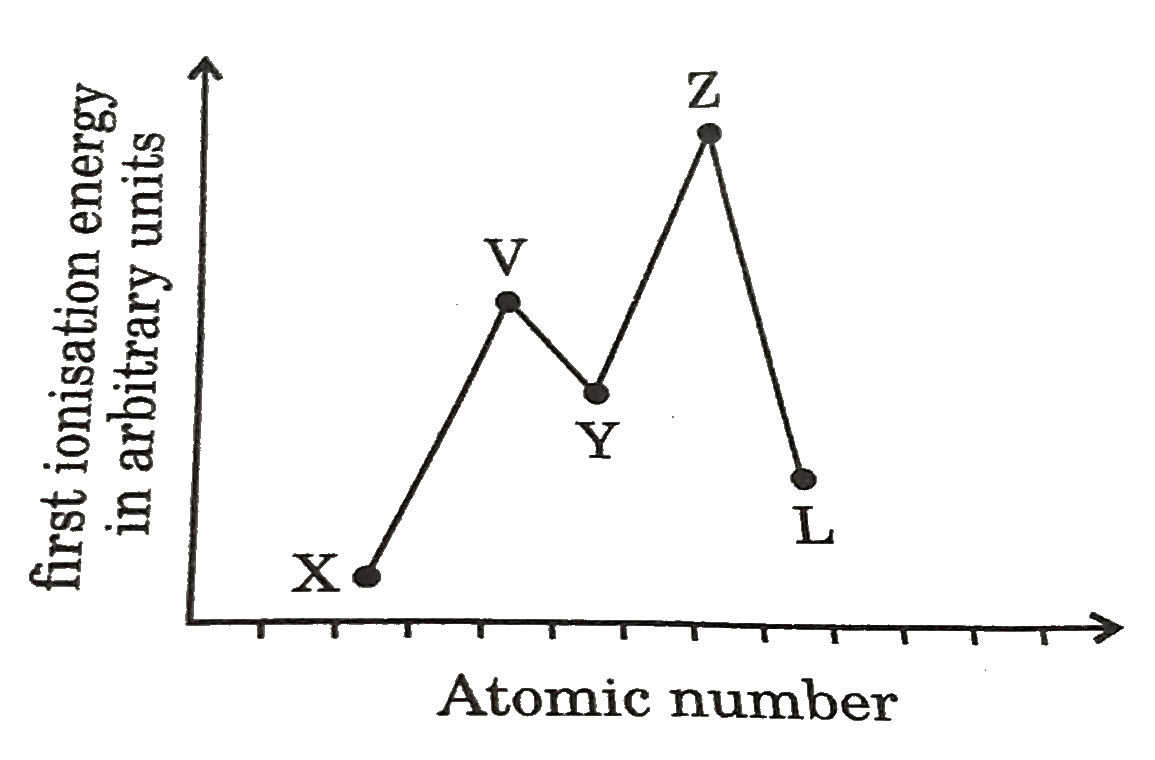 View Solution
View SolutionQuestion 542
An atom is assumed to tbe spherical in shape and thus, the size of atom is generally given in terms of radius of the sphere and is called atomic radius. It is usually defined as the distance between the centre of the nucleus and outermost shell where electron are present. The exact measure of atomic radius is not easy due to following reasons:
(i) The atom does not have well defined boundary. the probability of finding the electron is never zero even at large distance from the nucleus.
(ii) It is not possible to get an isolated atom. the electron density around an atom is affected by the presence of neighbouring atoms, i.e., the size of the atom changes in going from one set of environement to another.
(iii) the size of an atom is very small, of the order of about 1.2 Å,i.e., 1.2×10−10m.
An estimate of the size of the atom can, however, be made by knowing the distance betweent he atoms in the combined state. the distance between the atoms, i.e., bond length are generally measured by the application of techniques such as X-ray differaction, electron diffraction, infrared spectroscopy, nuclear magnetic resonance spectroscopy, etc. However, bond lengths change with different type of bonding. Three types of radius are commonly used, i.e.,
(a) Covalent radius (b) crystals radius (c) Vander waal's radius
The correct order of effective nuclear charge Zeff is View SolutionQuestion 543
An atom is assumed to tbe spherical in shape and thus, the size of atom is generally given in terms of radius of the sphere and is called atomic radius. It is usually defined as the distance between the centre of the nucleus and outermost shell where electron are present. The exact measure of atomic radius is not easy due to following reasons:
(i) The atom does not have well defined boundary. the probability of finding the electron is never zero even at large distance from the nucleus.
(ii) It is not possible to get an isolated atom. the electron density around an atom is affected by the presence of neighbouring atoms, i.e., the size of the atom changes in going from one set of environement to another.
(iii) the size of an atom is very small, of the order of about 1.2 Å,i.e., 1.2×10−10m.
An estimate of the size of the atom can, however, be made by knowing the distance betweent he atoms in the combined state. the distance between the atoms, i.e., bond length are generally measured by the application of techniques such as X-ray differaction, electron diffraction, infrared spectroscopy, nuclear magnetic resonance spectroscopy, etc. However, bond lengths change with different type of bonding. Three types of radius are commonly used, i.e.,
(a) Covalent radius (b) crystals radius (c) Vander waal's radius
Choose incorrect option regarding atomic radius View SolutionQuestion 544
An atom is assumed to tbe spherical in shape and thus, the size of atom is generally given in terms of radius of the sphere and is called atomic radius. It is usually defined as the distance between the centre of the nucleus and outermost shell where electron are present. The exact measure of atomic radius is not easy due to following reasons:
(i) The atom does not have well defined boundary. the probability of finding the electron is never zero even at large distance from the nucleus.
(ii) It is not possible to get an isolated atom. the electron density around an atom is affected by the presence of neighbouring atoms, i.e., the size of the atom changes in going from one set of environement to another.
(iii) the size of an atom is very small, of the order of about 1.2 Å,i.e., 1.2×10−10m.
An estimate of the size of the atom can, however, be made by knowing the distance betweent he atoms in the combined state. the distance between the atoms, i.e., bond length are generally measured by the application of techniques such as X-ray differaction, electron diffraction, infrared spectroscopy, nuclear magnetic resonance spectroscopy, etc. However, bond lengths change with different type of bonding. Three types of radius are commonly used, i.e.,
(a) Covalent radius (b) crystals radius (c) Vander waal's radius
Atomic radius of atoms in a period decreases with the increases in Zeff which of the following is incorrect order of atomic radius ?View SolutionQuestion 545
An atom is assumed to tbe spherical in shape and thus, the size of atom is generally given in terms of radius of the sphere and is called atomic radius. It is usually defined as the distance between the centre of the nucleus and outermost shell where electron are present. The exact measure of atomic radius is not easy due to following reasons:
(i) The atom does not have well defined boundary. the probability of finding the electron is never zero even at large distance from the nucleus.
(ii) It is not possible to get an isolated atom. the electron density around an atom is affected by the presence of neighbouring atoms, i.e., the size of the atom changes in going from one set of environement to another.
(iii) the size of an atom is very small, of the order of about 1.2 Å,i.e., 1.2×10−10m.
An estimate of the size of the atom can, however, be made by knowing the distance betweent he atoms in the combined state. the distance between the atoms, i.e., bond length are generally measured by the application of techniques such as X-ray differaction, electron diffraction, infrared spectroscopy, nuclear magnetic resonance spectroscopy, etc. However, bond lengths change with different type of bonding. Three types of radius are commonly used, i.e.,
(a) Covalent radius (b) crystals radius (c) Vander waal's radius
Choose incorrect option regarding atomic sizeView SolutionQuestion 546
An atom is assumed to be spherical in shape and thus, the size of atom is generally in term of radius of the sphere and is called atomic radius. It is usually defined as the distance between the centre of the nucleus and outermost shell where electron or electrons are present. The exact measure of atomic radius is not easy due to following reasons :
(a) The atom does not have well defined boundary. The propability of finding the electron is never zero even at large distance from the nucleus.
(b) It is not distances from to get an isolated atom. The electron density around an atom is affected by the presence of neighbouring atoms, i.e., the size of the atom changes in going from one set of environment to another.
(c ) The size of an atom is very small, of the order of abouit 1.2Å, i.e., 1.2×10−10m.
An estimate of the size of the atom can, however, be made by knowing the distance between the atoms in the combined state. The distance between the atoms, i.e., bond lengths are generally measured by the application of techniques such as X-ray diffraction, electron diffraction, infrared spectroscpy, nuclear magnetic resonance spectroscopy, etc. However, bond length change with different type of bonding. Three types of radius are commonly used, i.e.,
(a) Covalent radius (b) Crystal radius
(c ) van der Waal's radius
Which of the following set of ions have the same value of screening constant for the valence electron, calculated from Slater's rule?View SolutionQuestion 550
In the modern period table, elements are arranged in order of increasing atomic number which is related to the electric configuration. Depending upon the type of orbitals receving the last electron, the elements in the periodic table have been diviced into four blocks viz s,p,d and f. The modern periodic table consists of 7 periods and 18 groups. Each period being with the filling of a new energy shell. In according with the Aufbua principle, the seven periods (1 to 7) have 2,8, 8, 18, 18, 32 and 32 elements respectively. The seventh period is still incomplete. To avoid the periodic table being too long, the two series of f-block elements, called lanthanodis and actionoids are placed at the bottom of the main body of the periodic table.
The element with atomic number 57 belongs to:View SolutionQuestion 551
In the modern period table, elements are arranged in order of increasing atomic number which is related to the electric configuration. Depending upon the type of orbitals receving the last electron, the elements in the periodic table have been diviced into four blocks viz s,p,d and f. The modern periodic table consists of 7 periods and 18 groups. Each period being with the filling of a new energy shell. In according with the Aufbua principle, the seven periods (1 to 7) have 2,8, 8, 18, 18, 32 and 32 elements respectively. The seventh period is still incomplete. To avoid the periodic table being too long, the two series of f-block elements, called lanthanodis and actionoids are placed at the bottom of the main body of the periodic table.
The last element of p-block in 6th period is represented by the outermost electronic configuration. View SolutionQuestion 552
In the modern period table, elements are arranged in order of increasing atomic number which is related to the electric configuration. Depending upon the type of orbitals receving the last electron, the elements in the periodic table have been diviced into four blocks viz s,p,d and f. The modern periodic table consists of 7 periods and 18 groups. Each period being with the filling of a new energy shell. In according with the Aufbua principle, the seven periods (1 to 7) have 2,8, 8, 18, 18, 32 and 32 elements respectively. The seventh period is still incomplete. To avoid the periodic table being too long, the two series of f-block elements, called lanthanodis and actionoids are placed at the bottom of the main body of the periodic table.
Which of the elements whose atomic numbers are given below, cannot be accommodated in the present set up of the long form of the pariodic table?View SolutionQuestion 553
In the modern periodic table, elements are arranged in order of increasing atomic numbers, which is related to the electornic configuration. Depending upon the type of orbitals receiving the last electron, the elements in the periodic table have been divided into four blocks, viz, p,d and f. The modern periodic table consists of 7 periods and 18 groups. Each period begins with the filling of a new energy shell. in accordance with the Aufbau principal, the seven periods (1 to 7) have 2,8,8,18,18,32 and 32 elements respectively. The seventh period is still incomplete. To avoid the periodic table being too long, the two series of f-block elements, called lanthanoids and actinoids, are placed at the bottom of the main body of the periodic table
The electronic configuration of the element which is just above the element with atomic number 43 in the same group is View SolutionQuestion 554
In the modern periodic table, elements are arranged in order of increasing atomic numbers, which is related to the electornic configuration. Depending upon the type of orbitals receiving the last electron, the elements in the periodic table have been divided into four blocks, viz, p,d and f. The modern periodic table consists of 7 periods and 18 groups. Each period begins with the filling of a new energy shell. in accordance with the Aufbau principal, the seven periods (1 to 7) have 2,8,8,18,18,32 and 32 elements respectively. The seventh period is still incomplete. To avoid the periodic table being too long, the two series of f-block elements, called lanthanoids and actinoids, are placed at the bottom of the main body of the periodic table
The elements with atomic numbers 35,53 and 85 are all View SolutionQuestion 559
In 1931, Pauling defined the electronegativity of an atom as the tendency of the atom to attract electrons to itself when combined in a compound. The implication is that when a covalent bond is formed, the electrons used for bonding need not be shared equally by both atoms. If the bonding electrons spend more time around one atom, that atom will have a ∂−charge, and consequently the other atom will have a ∂+ charge. In the extreme case, where the bonding electrons are round one atom all of the time, the bond is ionic. Pauling and others have attempted to relate the electronegativity difference between two atoms to the amount of ionic character in the bond between them.
Mulliken
In 1934, Mulliken suggested an alternative approach to electronegativity based on the ionization energy and electron affinity of an atom. Consider two atoms A and B. If an electron is transferred from A to B, forming ions A+ and B−, then the energy change is the ionization energy of atom A(IA) minus the electron affinity of atom B(EB), that is IA−EB. Alternatively, if the electron was transferred the other way to give B+ and A− ions, then the energy changed would be IB−IA. If A+ and B− are actually formed, then this process require less energy , and
(IA−EB)<(IB−EA)
Rerranging (IA+EA)<(IA−EB)
Now with respect to electronegativity for the same change, E.NA<E.NB.
Thus Mulliken suggested that electronegativity is proportional to I.E+E.A and could be regarded as the average of the ionization energy and the electron affinity of an atom.
Electronegativity =(I+E)2
Mulliken used I and E values measured in electron volts, and the values were about 2.8 times alrger than the Pauling values. It is to be noted that I.E. and E.A values are defined for singular gaseous atoms.
We have X atoms of A. if all the atoms gain one electron each the energy released is aeV. If Y atoms of A lose one electron each, then the energy absorbed is beV. Then the electronegativity of A on the Mulliken scale will be:View SolutionQuestion 560
In 1931, Pauling defined the electronegativity of an atom as the tendency of the atom to attract electrons to itself when combined in a compound. The implication is that when a covalent bond is formed, the electrons used for bonding need not be shared equally by both atoms. If the bonding electrons spend more time around one atom, that atom will have a ∂−charge, and consequently the other atom will have a ∂+ charge. In the extreme case, where the bonding electrons are round one atom all of the time, the bond is ionic. Pauling and others have attempted to relate the electronegativity difference between two atoms to the amount of ionic character in the bond between them.
Mulliken
In 1934, Mulliken suggested an alternative approach to electronegativity based on the ionization energy and electron affinity of an atom. Consider two atoms A and B. If an electron is transferred from A to B, forming ions A+ and B−, then the energy change is the ionization energy of atom A(IA) minus the electron affinity of atom B(EB), that is IA−EB. Alternatively, if the electron was transferred the other way to give B+ and A− ions, then the energy changed would be IB−IA. If A+ and B− are actually formed, then this process require less energy , and
(IA−EB)<(IB−EA)
Rerranging (IA+EA)<(IA−EB)
Now with respect to electronegativity for the same change, E.NA<E.NB.
Thus Mulliken suggested that electronegativity is proportional to I.E+E.A and could be regarded as the average of the ionization energy and the electron affinity of an atom.
Electronegativity =(I+E)2
Mulliken used I and E values measured in electron volts, and the values were about 2.8 times alrger than the Pauling values. It is to be noted that I.E. and E.A values are defined for singular gaseous atoms.
For the reaction A(g)+e−→A+(g)ΔHr=ΔHeg. The enthalpy change will be equal to (magnitude wise):View SolutionQuestion 561
In 1931, Pauling defined the electronegativity of an atom as the tendency of the atom to attract electrons to itself when combined in a compound. The implication is that when a covalent bond is formed, the electrons used for bonding need not be shared equally by both atoms. If the bonding electrons spend more time around one atom, that atom will have a ∂−charge, and consequently the other atom will have a ∂+ charge. In the extreme case, where the bonding electrons are round one atom all of the time, the bond is ionic. Pauling and others have attempted to relate the electronegativity difference between two atoms to the amount of ionic character in the bond between them.
Mulliken
In 1934, Mulliken suggested an alternative approach to electronegativity based on the ionization energy and electron affinity of an atom. Consider two atoms A and B. If an electron is transferred from A to B, forming ions A+ and B−, then the energy change is the ionization energy of atom A(IA) minus the electron affinity of atom B(EB), that is IA−EB. Alternatively, if the electron was transferred the other way to give B+ and A− ions, then the energy changed would be IB−IA. If A+ and B− are actually formed, then this process require less energy , and
(IA−EB)<(IB−EA)
Rerranging (IA+EA)<(IA−EB)
Now with respect to electronegativity for the same change, E.NA<E.NB.
Thus Mulliken suggested that electronegativity is proportional to I.E+E.A and could be regarded as the average of the ionization energy and the electron affinity of an atom.
Electronegativity =(I+E)2
Mulliken used I and E values measured in electron volts, and the values were about 2.8 times alrger than the Pauling values. It is to be noted that I.E. and E.A values are defined for singular gaseous atoms.
For a reaction A(g)+B(g)rarAB(S) the enthalpy change for the recation will be [assuming AB(s) to be an ionic compound] If I.EA+E.AA<I.EB+E.ABView SolutionQuestion 564
The amount of energy released when an electron is added to an isolated gaseous atom to produce a monovalent anion is called electron affinity of first electron affinity or electron gain enthalpy. The first electron affinity is given a negative sign as the addition of an electron to a neutral atom is an exoergic process. The addition of electron to A− requires energy to overcome the force of repulsion. Thus, the second electron affinity is an endoergic process. The magnitude of electron affinity depends on a number of factors such as (i) atomic size (ii) effective nuclear charge (iii) screening effects (iv) half and fully filled orbitals and (v) shape of orbital. In general, electron affinity increase as the atomic radii decrease in a period. However, there are exceptions when the atoms have stable configuration. In a group, electron affinity decreases as the size increases. However, the members of 3rd period have somewhat higher values than the members in the 2nd period of the same subgroups.
Which one of the following arrangements represents the correct order of electron gain enthalpy (with negative spin) of the given atomic species? View SolutionQuestion 565
The amount of energy released when an electron is added to an isolated gaseous atom to produce a monovalent anion is called electron affinity of first electron affinity or electron gain enthalpy. The first electron affinity is given a negative sign as the addition of an electron to a neutral atom is an exoergic process. The addition of electron to A− requires energy to overcome the force of repulsion. Thus, the second electron affinity is an endoergic process. The magnitude of electron affinity depends on a number of factors such as (i) atomic size (ii) effective nuclear charge (iii) screening effects (iv) half and fully filled orbitals and (v) shape of orbital. In general, electron affinity increase as the atomic radii decrease in a period. However, there are exceptions when the atoms have stable configuration. In a group, electron affinity decreases as the size increases. However, the members of 3rd period have somewhat higher values than the members in the 2nd period of the same subgroups.
Which of the following has least electron affinity? View SolutionQuestion 566
The amount of energy released when an electron is added to an isolated gaseous atom to produce a monovalent anion is called electron affinity of first electron affinity or electron gain enthalpy. The first electron affinity is given a negative sign as the addition of an electron to a neutral atom is an exoergic process. The addition of electron to A− requires energy to overcome the force of repulsion. Thus, the second electron affinity is an endoergic process. The magnitude of electron affinity depends on a number of factors such as (i) atomic size (ii) effective nuclear charge (iii) screening effects (iv) half and fully filled orbitals and (v) shape of orbital. In general, electron affinity increase as the atomic radii decrease in a period. However, there are exceptions when the atoms have stable configuration. In a group, electron affinity decreases as the size increases. However, the members of 3rd period have somewhat higher values than the members in the 2nd period of the same subgroups.
The electron affinities of halogens are:
F=−332,CI=−349,Br=−324,I=−295kJmol−1 The higher value of CI as compared to that of F− is due to: View SolutionQuestion 567
The amount of energy released when an electron is added to an isolated gaseous atom to produce a monovalent anion is called electron affinity of first electron affinity or electron gain enthalpy. The first electron affinity is given a negative sign as the addition of an electron to a neutral atom is an exoergic process. The addition of electron to A− requires energy to overcome the force of repulsion. Thus, the second electron affinity is an endoergic process. The magnitude of electron affinity depends on a number of factors such as (i) atomic size (ii) effective nuclear charge (iii) screening effects (iv) half and fully filled orbitals and (v) shape of orbital. In general, electron affinity increase as the atomic radii decrease in a period. However, there are exceptions when the atoms have stable configuration. In a group, electron affinity decreases as the size increases. However, the members of 3rd period have somewhat higher values than the members in the 2nd period of the same subgroups.
Which of the following species has the highest electron affinity?View SolutionQuestion 568
The properties of the elements (atomic/ionic radii, electron gain enthalpy, ionization enthalpy, electronegativity, valence, oxidising/reducing power, acid/base character, etc.) which are directly or indirectly related to their electronic configirations are called periodic properties. These properties show a regular gradation on moving from left to right in a period or form top to bottom in a group. Down a group, the atomic/ionic radii, metallic character and reducing character increase while ionization enthalpy and electronegativity decrease. Along a period from left to right, atomic/ionic and metallic character decrease while ionization enthaloy, electronegativity, non-metallic character and oxiding power increase. However, electron gain enthalpy becomes less negative down a group butmore negative along a period. In contrast, inert gases have positive electron gain enthalpies which do not show may regular trend.
If the ionic radii of K+ and F− are about 1.34Å each, then the expected value of atomic radii of K and F should be respectively: View SolutionQuestion 569
The properties of the elements (atomic/ionic radii, electron gain enthalpy, ionization enthalpy, electronegativity, valence, oxidising/reducing power, acid/base character, etc.) which are directly or indirectly related to their electronic configirations are called periodic properties. These properties show a regular gradation on moving from left to right in a period or form top to bottom in a group. Down a group, the atomic/ionic radii, metallic character and reducing character increase while ionization enthalpy and electronegativity decrease. Along a period from left to right, atomic/ionic and metallic character decrease while ionization enthaloy, electronegativity, non-metallic character and oxiding power increase. However, electron gain enthalpy becomes less negative down a group butmore negative along a period. In contrast, inert gases have positive electron gain enthalpies which do not show may regular trend.
Which of the following isoelectronic ions has the lowest first ionization enthalpy?View SolutionQuestion 570
The properties of the elements (atomic/ionic radii, electron gain enthalpy, ionization enthalpy, electronegativity, valence, oxidising/reducing power, acid/base character, etc.) which are directly or indirectly related to their electronic configirations are called periodic properties. These properties show a regular gradation on moving from left to right in a period or form top to bottom in a group. Down a group, the atomic/ionic radii, metallic character and reducing character increase while ionization enthalpy and electronegativity decrease. Along a period from left to right, atomic/ionic and metallic character decrease while ionization enthaloy, electronegativity, non-metallic character and oxiding power increase. However, electron gain enthalpy becomes less negative down a group butmore negative along a period. In contrast, inert gases have positive electron gain enthalpies which do not show may regular trend.
The outermost electronic configuration of the most electronegative elements is:View SolutionQuestion 571
The properties of the elements (atomic/ionic radii, electron gain enthalpy, ionization enthalpy, electronegativity, valence, oxidising/reducing power, acid/base character, etc.) which are directly or indirectly related to their electronic configirations are called periodic properties. These properties show a regular gradation on moving from left to right in a period or form top to bottom in a group. Down a group, the atomic/ionic radii, metallic character and reducing character increase while ionization enthalpy and electronegativity decrease. Along a period from left to right, atomic/ionic and metallic character decrease while ionization enthaloy, electronegativity, non-metallic character and oxiding power increase. However, electron gain enthalpy becomes less negative down a group butmore negative along a period. In contrast, inert gases have positive electron gain enthalpies which do not show may regular trend.
Amomgst the following elements (whose electronic configurations are given below) the one having the highest ionization enthalpy is :View SolutionQuestion 572
The properties of the elements (atomic/ionic radii, electron gain enthalpy, ionization enthalpy, electronegativity, valence, oxidising/reducing power, acid/base character, etc.) which are directly or indirectly related to their electronic configirations are called periodic properties. These properties show a regular gradation on moving from left to right in a period or form top to bottom in a group. Down a group, the atomic/ionic radii, metallic character and reducing character increase while ionization enthalpy and electronegativity decrease. Along a period from left to right, atomic/ionic and metallic character decrease while ionization enthaloy, electronegativity, non-metallic character and oxiding power increase. However, electron gain enthalpy becomes less negative down a group butmore negative along a period. In contrast, inert gases have positive electron gain enthalpies which do not show may regular trend.
Tick the correct order of second ionization enthalpy in the following: View SolutionQuestion 573
A quantitative measure of the tendency of an element to lose electron is given by its ionization enthalpy. It represents the energy required to remove an electron from an isolated gaseous atom (X) in its ground state. In other words, the first ionization enthalpy for an element X is the enthalpy change (ΔiH) for the reaction depicted.
X(g)→X+(g)+e−
The ionization enthalpy is expressed in units of kJmol−1. We can define the second ionization enthalpy as the energy required to remove the second most loosely bound electron: it is the energy required to carry out the reaction,
X+(g)→X2+(g)+e−
Largest energy is required for which change? View SolutionQuestion 574
A quantitative measure of the tendency of an element to lose electron is given by its ionization enthalpy. It represents the energy required to remove an electron from an isolated gaseous atom (X) in its ground state. In other words, the first ionization enthalpy for an element X is the enthalpy change (ΔiH) for the reaction depicted.
X(g)→X+(g)+e−
The ionization enthalpy is expressed in units of kJmol−1. We can define the second ionization enthalpy as the energy required to remove the second most loosely bound electron: it is the energy required to carry out the reaction,
X+(g)→X2+(g)+e−
Consider following statements for the two uncharged gaseous species
Species -1 =1s2,2s1 Species -2 =1s2,2p1
(P) Species-1 is ground state, species-2 is excited state of same atom
(Q) Species-1 is excited state, species-2 is ground state of same atom
(R) Ionization of species-1 is easier as compared to species-2
(S) Ionization of species-2 is easier as compared to species-1
Select correct statement(s)View SolutionQuestion 610
0.5 moles of gaseous non-metallic X− anions (having positive electron affinity) requires 806.4 kJ energy to get completely converted into gaseous X+ ions. Calculate Pauling's electronegativity of the elements X. Use Avogardo's no =6×1023 and 1eV=1.6×10−19J.
[Use the fact that, Pauling's electronegativity
=Mulliken's electronegativity2.8 and Mulliken's electronegativity =Ionisation energy+ Electron affinity2]View SolutionQuestion 628
Find the total number of correct orders among the following.
(a) Order of electron affinity : S>O−
(b) Order of ionic radius: AI3+<Mg2+<O2−
(c) Order of electronegativity: Si<P<C<N
(d) Order of atomic radius: O<C<S<Se
(e) Order of second ionization energy: C<N<F<O
(f) Order of ionic radii : S2−<CI−<K+<Ca2+View Solution
All Exercises from GRB CHEMISTRY (HINGLISH) Class 11 CHEMISTRY PERIODIC TABLE
- A.DEVELOPMENT OF PERIODIC TABLE, PERIOD, GROUP AND BLOCK
- B.ATOMIC AND IONIC RADIUS
- C.IONISATION ENERGY
- COMPREHENSION
- COMPREHENSION 1
- COMPREHENSION 10
- COMPREHENSION 11
- COMPREHENSION 12
- COMPREHENSION 13
- COMPREHENSION 14
- COMPREHENSION 15
- COMPREHENSION 16
- COMPREHENSION 17
- COMPREHENSION 18
- COMPREHENSION 19
- COMPREHENSION 2
- COMPREHENSION 20
- COMPREHENSION 3
- COMPREHENSION 4
- COMPREHENSION 5
- COMPREHENSION 6
- COMPREHENSION 7
- COMPREHENSION 8
- COMPREHENSION 9
- D. ELECTRON GAIN ENTHALPY (ELECTRON AFFINITY)
- E.ELECTRONEGATIVITY
- F.ACIDIC-BASIC CHARACTER, HYDRATION ETC.
- MATCH THE COLUMN TYPE
- MULTIPLE OBJECTIVE TYPE
- REASONING TYPE
- SUBJECTIVE TYPE

